First Community Bake of the New Year. This month seems less like 'Dry January' and more like 'Rye January'. So it seems very fitting to make rye the centrepiece (sorry! centerpiece) for this collective bake.
There has been much discussion about the "rules" for this community bake but I wish to make it simple so it's accessible and all inclusive. The one rule is that rye must make up at least 50% of the flour/grain in the dough. Other then that... surprise us!
It is customary for the 'host' to start off with a bake of their own. While I have recently made a rye bread I haven't done one especially for this community bake in mind. That bake will be coming soon. And what's more I don't consider myself the host as i'm just getting this off the ground and on the way. I will do my best to step into Dan's and Alan's shoes however I won't be able to devote as much time for which I apologise (sorry! apologize) in advance. We can all play host and with a collective effort I believe it'll keep itself running.
Here is an introduction to baking with rye and I will leave you with is a really lovely rye recipe from our friends over at breadtopia. Over to you Eric...
Artisan Sourdough Rye Bread

This is my favorite rye bread recipe of all time… so far. I could have just as easily called it Swedish Rye Bread or Aroma Therapy Bread for that matter (takes the coveted baking bread smell to another level). Covers both sourdough and instant yeast versions.
Ingredients
- Water: 400 grams, 1 2/3 cups
- Sourdough Starter: 70 grams, 1/3 cup (omit if making the instant yeast version)
- Instant Yeast: 1 tsp (omit if making sourdough leavened version)
- Whole Rye Flour: 245 grams, heaping 1 3/4 cups
- Bread Flour: 245 grams, heaping 1 3/4 cups [my tip: use very strong bread flour]
- Molasses: 44 grams, 2 Tbs
- Fennel Seed: 8 grams, 1 Tbs
- Anise Seed: 2 grams, 1 tsp
- Caraway Seed: 3 grams, 1 tsp
- Salt: 12 grams, 1 3/4 tsp
- Zest of 1 Orange
Instructions
Sourdough Version
- In a mixing bowl, mix the starter into the water. Add the molasses, all the seeds and orange zest.
- In a separate bowl, combine the flours and salt.
- Gradually stir the dry ingredients into the wet using a dough whisk or spoon until the flour is well incorporated. Cover with plastic and let rest for 15 minutes. After about 15 minutes, mix again for a minute or two. Again let rest for 15 minutes and mix one more time as before. Now cover the bowl with plastic and let sit at room temperature for roughly 12-14 hours.
Instant Yeast Version
- The only difference is don’t use sourdough starter and instead mix the instant yeast into the dry ingredients before combining with the wet ingredients.
Both Versions
- After the long 12-14 hour proof, stretch and fold the dough and shape into boule or batard (round or oblong) shape for baking. (If you didn’t follow that, I’m afraid you’re doomed to watch the video.) Cover again with plastic and let rest 15 minutes before putting in a proofing basket for the final rise. If you don’t have a proofing basket, line a bowl with a well floured kitchen towel and put the dough in there for the final rise. The final rise should last somewhere between 1 to 1 1/2 hours. Keep the dough covered with plastic to prevent it from drying out.
- Preheat your oven to 475 F a half hour before baking.
- Score the dough with a razor or sharp serrated knife and bake until the internal temp is about 200 F.
- Let cool completely before eating.
Notes
On 12-14 hour proofing period: I typically prepare everything in the evening for baking the next morning. You can also mix everything up in the morning and refrigerate until evening then remove before bed to resume the proofing at room temperature. Alternatively, if you get started with mixing everything up early enough in the morning, the bread can also be ready to bake in the evening [you can keep an eye on the dough this way]. This is a nice option when you want fresh bread ready to eat for breakfast.
https://breadtopia.com/sourdough-rye-bread/
_______________________________________________________________________
Good Resources For Rye Recipes:
https://brotdoc.com/2021/09/05/landbrot-nach-alter-art/
https://www.thefreshloaf.com/node/67054/100-whole-grain-rye-sourdough-bread
https://www.kingarthurbaking.com/recipes/jeffreys-sourdough-rye-bread-recipe
https://www.theperfectloaf.com/rye-sourdough-and-smorrebrod/
http://brotgost.blogspot.com/ (you can change the language to English)
https://www.ploetzblog.de/tag/roggenbrot/ (you can change the language to English)
https://www.thefreshloaf.com/node/15736/mini039s-favorite-rye-ratio (from our very own Mini)
Volkornbrot [A recipe from kingdombread-tampa over on YouTube. Alan first introduced this baker to us back in February 2021: https://www.thefreshloaf.com/node/67469/polenta-levain-kingdom-bakery-tampa-fl]
American Pumpernickel An adaptation of German Pumpernickel aka Old Milwaukee Rye. No need to bake it for up to 18 hours. Not 50% rye but we'll accept it in place of German Pumpernickel and pretend it checks all the right boxes. Not everyone is happy about baking a loaf for so long and this recipe allows one to appreciate "Pumpernickel" with a bit more ease.
Yeasted Polish Rye Bread : A nice channel on YouTube. Unfortunately she doesn't post any videos anymore. However here is a yeasted Polish Rye Bread for those who don't have a sourdough starter.
_______________________________________________________________________
The following are links to some of our previous Community Bakes
- Lake Champlain Sourdough by Trevor Wilson
- Fifty-Fifty Whole Wheat Sourdough by Maurizio Leo
- Soughdough Baguettes by Maurizio Leo
- 1-2-3 Sourdough by Flo Makanai
- Five-Grain Levain by Jeffrey Hamelman
- Maurizio's Oat Porridge SD by Maurizio Leo
- Community Bake - Pizza
- Hamelman’s Swiss Farmhouse Bread - Yeast Water - Part 1 by Jeffrey Hamelman
- Hamelman’s Swiss Farmhouse Bread - The Bread - Part 2 by Jeffrey Hamelman
- Basic Open Crumb Sourdough by Kristen of FullProofBaking
- The Approachable Loaf- Whole Wheat Sandwich Bread by The Bread Lab
- Baguettes featuring Alfanso
- Deli Rye - NY Jewish Bakery/Deli style Rye breads
- Durum - Semolina Breads
- Babka
- Portuguese Style Hawaiian Sweet Bread
- Ciabatta
All bakers of any skill level is invited and encouraged to join in. The Community Bakes are not competitive events. There are no winners and losers. Everyone that actively participants is guaranteed to learn something(s) new.
Some Community Bakes get extremely large. If you find that you are getting too many notifications of new replies and would like to decrease or stop the messages SEE THIS LINK.
Agree with Benny - gorgeous, man. My wife is going up to see her mom and dad on Friday - mom's Estonian and dad is, well, a morphed Estonian and both are mad for rye. I have about a dozen bookmarks in Stanley's book and this is one of them, but I've never made it. You've bumped any other plans and this one is next. Starting tomorrow, perfect for Friday morning breakfast for them.
Thanks much!
Thanks Gadjowheaty - I would increase the bread spices a little - but then again I enjoy stronger flavors.
How about a slice of Rye Gingerbread (LINK) for dessert? Slightly bending the rules, but it is a "bread" of sorts. 100% KA medium rye with a nice clove kick, which I like (I used to chew Adams Clove Gum as a kid).
There you go, very nice!
Adams Clove - oh man, brings back memories. My dad was a pilot and the gum of choice to clear our ears in the old Cessnas was....
Oh yummy, nice gingerbread! I’ve never seen a rye gingerbread.
Thanks, Benny. The rye really compliments the spiciness of the cake. Or is it the other way around?
Kümmel-Bier Brot (Caraway Beer Bread) from The Rye Baker book. This bread is for lovers of caraway seed (sorry Benny!); it has a whopping 2% caraway seed. The bread is 50% rye and 50% first clear or high-gluten flour, barley malt syrup, and beer for half the liquid. The bread is great for sandwiches. For those not as fond of caraway as I am, it could still be a good all-around rye sandwich bread if the caraway was reduced or omitted. More details on the prep here.
James Morton's "Purely Rye Sourdough" recipe left me full of self doubt. His approach is unconventional, as he puts it, "The way I get a brilliant pure rye bread is to follow every traditional process of conventional breadmaking, but bake it just like you might a gluten-free loaf."
So the recipe has some oddities to it, some more strange than others, "you need to knead this bread"(!), long fermentation time - 6 hours bulk plus 4-6 hours proof, score(!) the top of the loaf, and "bash" out of the tin halfway through the short bake.
I used Pstros' variant for the ingredients, so half the levain was bread flour making this a 90% rye, and also used 100g of cooked rye kernels both inside the bread and as a topping. I humoured the recipe and mixed for 15 minutes with the paddle. Maybe, just maybe, the strands from the side of the bowl to the dough clinging to the paddle were just a little bit more coherent at the end of that. I didn't want to try shaping fizzy mud, so gave it a much shorter bulk of 2 hours, but then left it in the pan quite a long time as I was away. Think it went too far for what I would have liked - aliquot at 200% - 9 hours from adding levain (3X increase) and the top was pinholed. Instead of scoring I brushed on whey and used that to attach the sunflower seeds and cooked rye (thanks Mini!).
And because I'm an idiot who follows instructions, and my pan wasn't non-stick, I ended up having to try twice - the "bash the bread out after 20 minutes" was a disaster, even though the pan was oiled it stuck at the base as that wasn't properly cooked 20 min in, and my first loaf ended up as a collection of chunks. So, I took the hit (and froze some for altus) and actually tried all over again the next day, this time with butter to grease a new non stick pan and I baked on top of the baking steel for 25 minutes before seeing if it would come gently out of the pan, which it did. I made sure this was properly baked, so this one had a total of 60 minutes at 200°C (392°F) of which 20 minutes had foil tenting. Slight darkening on top, but that's okay with me.
Left it all properly wrapped and only sliced and tasted at 36 hours - turned out to taste nicer than I thought it would. Complicated flavours, a slight tang but not an over-powering sourness, liked the cooked rye kernels, and no gumminess to the crumb. Going to enjoy eating the rest, which leaves me confused what to think of this recipe!
Sounds like you’re happy you had a second go at this recipe Jon. In the end you baked up a nice looking loaf despite the unusual processes.
Benny
Here is my second submission: my second attempt at Hamelman’s Horst Bandel Black Pumpernickel. I’m reasonably happy with this one, although there’s room for improvement.
Image
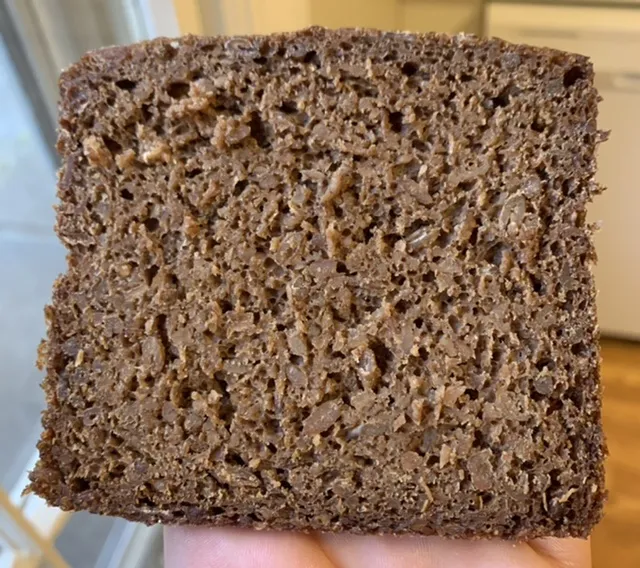
I used my first attempt in the old bread soaker, which may have made the bread slightly too full of rye kernels. As with the first attempt, I found the amount of water in the recipe too much (would have turned the dough into pancake batter) and had to hold some of it back.
When perusing old threads on this bread, I noticed a wide range of baking techniques. In an attempt to achieve a dark color, I went for a long bake: 1 hour at 350, 2.5-3 hours at 275, 9-10 hours at 220. My oven does not retain heat well, so turning it off and leaving it as Hamelman recommends would not have accomplished much. Despite the long bake, the crust was not hard or tough at all.
Note: after wrapping my Pullman pan in a couple layers of foil, I put the baking stone on top of it for the duration of the bake. Maybe that’s a bad idea, but the stone and pan seem fine, and the bread stayed moist.
60% rye/40% spelt
2 stage ferment with a stale bread scald
recipe: https://www-ploetzblog-de.translate.goog/2021/05/29/bergkruste-sauerteigbrot-mit-roggen-und-dinkel/
This is a really interesting formula. The dough was super tangy (not surprising given that my schedule extended the preferment to 18 hours) but the final loaf was surprisingly mild, with the spelt nutty sweetness overcoming the spicy rye. It'll make a great feast with the squash soup I made last night.
Rob
That does look interesting (and tasty!). I'll have to add this one to my list.
Did you use the bolted spelt flour for the final dough? I only have whole spelt flour, but I suppose it's a small quantity and shouldn't make much difference.
How do you interpret the baking instructions? I'm always a bit confused by the German baking instructions. Is steam applied during the entire bake? How long is the oven maintained at the higher temperature?
I used whole rye and whole spelt -- because that's what I have. This probably made the dough a little more stiff.
I bootlegged the temperatures and steam. Going against my pyromaniac instincts, I rejected 280C/535F as the starting temperature. Since my whole grain dough was less slack, I figured I didn't need to set it aflame in the oven.
I started at 250C/485F for 20 minutes -- with steam for the first 15. Then I lowered it to 232C/450F for 30 minutes. And I finished up at 210C/410F for ten minutes.
One other variation: I don't know why, but I did the 2-stage preferment without salt (no doubt, this upped the sourness substantially.) And the total salt I added to the final dough -- mixed in with the hot water and the cooled scald -- was 7 grams. This was just personal preference: I find most bread formulas are too salty.
I was blown away that, though the raw dough was incredibly acidic, the final bread was quite mellow. With each bite, I feel like I'm in the mountains.
Delicious bread and lovely hands off procedure
Image
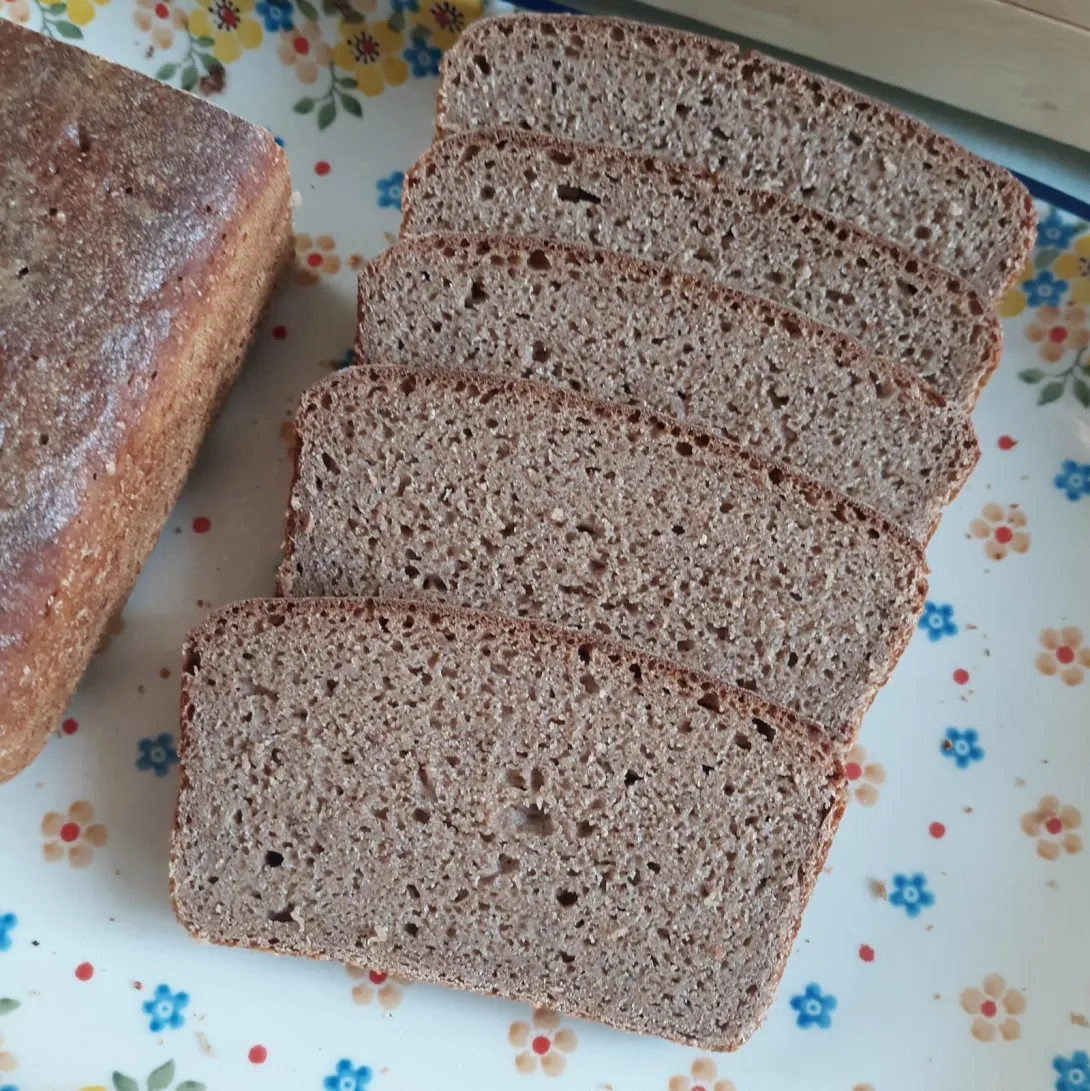
Very even crumb and unique technique. Not too airy but still looks like a soft crumb. Making this over a few days would sure bring out some wonderful flavours. Very nice indeed and welcome to the Community Bake.
It's a very nice, simple tasting everyday rye bread. It has a pronounced acidity with some lemony notes to it 😋
Do tell more!
Yes, at least that's how my palate perceives that. Maybe because of that dried starter on the sides of my bread bowl? I've been using this bowl for 3 years now, maybe some nice yeast and lactic bacteria sit there? You can read about the procedure in my blog post. It's based on traditional recipe from Belarus
Repeated the previous bake with small modifications.
Stupidly, when mixing the preferment, I realized I only had half the amount of starter necessary for the recipe, so I just used what I had and added extra flour and water to get the total amount. The starter was more active than the first time (spent less time in the fridge) and I gave it an extra hour compared to last time, so the resulting preferment seemed very similar in the end.
I toasted 75 g of sunflower seeds and added them to the main dough, together with 4 g of bread spice (a little on the low side, I didn't want to overpower the flavour of the bread itself). I also thought the seeds would soak up a bit of water, so added extra 25 g water, but it actually was a mistake: the dough was way more soft than the first time, and although I mixed in a little more flour after the 30 min "bulk" ferment, it was still too liquidy. In addition (and probably due to that reason) it stuck a little during proofing, and removing the towel damaged the surface in a few spots, which then corresponded to the largest cracks on the loaf - which is also quite flat to due overhydration.
This time I didn't sprinkle the bread with water before taking it out, but I sprinked water on the walls of the oven. I don't know whether it made any difference for the hardness of the crust, but it did preserve the nice white-black contrast on the surface. Sliced it after two days.
[url=https://ibb.co/44fnSkZ] [/url]
[/url] [/url]
[/url]
[url=https://ibb.co/f4mrr48]
It's really tasty, with extra nuttiness from the seeds (could have used more!), and a little something from the spices too. Overall the flavour is very similar to the previous one, perhaps a little more moist (due to higher hydration). Very nice hearty bread, despite a somewhat low profile.
Really brings out flavour and the oil. Very nice crumb and crust, Ilya. Looks delicious.
Thank you Abe - indeed, toasted sunflower seeds are delicious, and I think work very well with rye bread.
Inspired by Ilya and cfraenkel's bakes, I also had a try at the Plötzblog recipe with "versäuertem Schrot" (https://www.ploetzblog.de/2020/09/12/roggenbrot-mit-versaeuertem-schrot/).
Everything was progressing nicely, until mixing the final dough. I had left a measuring cup of boiled water to cool to 70C, but then forgot that I hadn't weighed it out precisely, and just poured the whole thing into the bowl. I'd estimate I boosted the hydration by around 20% - on a recipe with a starting point of 85%! To salvage things I proofed and baked in a loaf pan, reducing the proof time by 30 minutes and taking it out of the pan a bit before the end of the bake to crisp the crust.
In the end it turned out surprisingly good, with a very moist and relatively open crumb thanks to all the extra water, contrasting nicely with a crisp but not at all tough crust. There are a couple small voids in the very center of the loaf so I think it was really on the brink of internal collapse during bake ... but managed to just hold together.
Nice! That looks really good. Maybe I should have baked my recent also somewhat overhydrated loaf in a pan! But high hydration rye in a pan makes for a very pleasant crumb, a moist and relatively open (but obviously less crust, which has lots of flavour! - tradeoff).
How do you like the taste?
...period!
Looks perfect to me. Rose well, very uniform and nice looking crumb structure. Cuts nicely. Perfection.
Bon Appetit, Mike.
That looks like it's going to be delicious. I'd be really happy to bake that, beautiful.
Nice save! I think I like the look of that even better than the original, but I'm partial to panned breads.
If you were to repeat it, would you increase the hydration to only 95–100%? Thanks.
I think you upgraded the recipe! Fantastic save!
Thanks all!
Ilya, the taste is very good - though there are a few "schrot" kernels that remained perhaps a little too crunchy.
Alcophile, I would up the hydration 10% max and see how it goes. Deeper into the loaf were a few more defects (slight "flying roof" in a couple spots) so again I think this was really pushed to the brink! (I also like the look of Pullman pans for rye breads - since the oven spring is limited, the taller format gives a nice proportion).
Sorry, I have been quiet for a while. That doesn't mean I haven't been following all your wonderful bakes. This Community Bake has taken me by surprise and has grown so much in this past week it's very difficult to comment on every bake. I have however followed every single one. Such wonderful recipes and ideas, more then I could have dreamed of, in just over a week too. Welcome back to regular contributors to the Community Bake and lovely to see some new 'faces' too.
On my way home from work I decided to pop into my local Polish store and buy some more wholegrain rye flour. Had to spend a certain amount on my card and now I have more then I know what to do with. I suppose I could have bought something else but was in a hurry and to make up for the minimum spend just grabbed another packet off the shelf. Never mind... with all the bakes here i won't be running out of ideas.
https://melvit.pl/en/wholemeal-rye-flour-1-kg/
Thank you, Abe, for organizing the CB.
I'm also thrilled to see so many different recipes that showcase rye. It will take me months to try them all!
I'm glad everyone is enjoying themselves. Your rye gingerbread looks so inviting! Reminds me of Icelandic Rye. While it doesn't have any ginger in it it's certainly leaning towards a rye cake with caramel notes.
Thank you for creating the CB, it's a pleasure to have you as the host, and hope you don't feel any pressure to comment one very bake. You are a busy person, and I think we all know you read through everything even if you don't comment :)
Enjoy the Polish flour, looking forward to seeing your bakes!
I did plan on trying to comment on all the bakes but i'm so happy I can't because the CM is so popular. That's what I like to see. Of course I pop in everyday and marvel at all the bakes.
Not sure what to make next. I'm spoiled for choice.
... so little time.
Thanks Abe, for coordinating & advising & marveling.
Much appreciated.
Rob
For your bake and recipe, Rob.
Something i've saved to try sometime.
Interesting that the bag of your Polish flour has a 'thermomix' logo on it - are you meant to do anything with a home appliance?
Also, out of curiosity did that shop also stock light/medium rye flour?
-Jon
It is a recipe for thermomix which I think is a home appliance which can do many things one of which is need dough (I would think). Here is the recipe:
Are you up for some google translate?
Everything is in Polish in that store but what I can make out is they sell wholemeal and white rye.
Prepare in Thermomix Wholemeal rye bread Method of preparation: Pour 250 g of buttermilk and 150 g of water into Thermomix, add 40 g of fresh yeast and a teaspoon of sugar, heat for 1 min / 37 ° C / Speed 2. Add 500 g of Melvit wholemeal rye flour, 1.5 teaspoons of salt, a tablespoon of oil, knead the dough with a spatula, time 2 minutes /. Put the dough into another vessel, leave it to rise for about 40 minutes, then put it into a greased baking tin (about 24x12x7 cm). Bake in a preheated oven at 200 ° C for 50-60 minutes. After removing from the oven, leave the bread in the form for about 10 minutes.
*Google Translate from photo
* "turn 2" was also translated as "speed 2"
Thank you, David. That's nifty. Google can translate from a photo!?
Now we have another recipe. More the merrier.
P.s. if anyone wishes to follow this recipe that would be 1.5 teaspoons of salt.
Yes, google translate app on the phone (or the translate function of google lens) can translate from a photo - or even from the camera in real time!
And try it out for myself. Thank you Ilya.
Sorry guys, nothing new to show. I'm with Abe. I wish we had a "madly blown away" emoticon as I'd be painting this thread with them. Amazed.
So this isn't on a current bake. My wife is driving up to see her parents, will be there for dinner Friday. Two breads - both from Lutz - Black Hamster and Rauriser Vollkornbrot. My in laws are in their 80's so I really have to watch the petrified lava effect on the Rauriser, but with Mini's and others' help, I think I have a handle on it. So my question is, when would you think the optimal "aging" would be for these two breads? Is there a consensus on full-rye recipes in general? I know it's subjective but, um, truth be told...
I can't stand not baking daily rye. Serious. Right now it's growing out our ears, though, and this bread for my FIL/MIL is a perfect reason to bake. Given Friday dinner first breaking of the breads, would you bake tomorrow, or Thursday?
Black Hamster Wholemeal Bread. Never heard of that before. Looks like a relative of the Danish Rye. Generally I find 2-3 days and it's really cutting nicely with the rye itself catching up with the flavours of the add-ins.
I agree, I think 2 days is optimal, after that I don't notice much change in flavour or crumb structure.
Looks superb - presumably if it is a hamster bread you must stuff your cheeks with it.
My entry into the Rye CB. Details are in my blog.
Perfect! The mash must be bringing out the reddish color?
Yes, I think so. Maybe more from the barley than the rye, but not sure on that. I have a picture of the finished mash in my blog that shows its color, and the reddish hues are definitely there. Could be the soft white lights in my kitchen are contributing to it too, but it does have a reddish color even in daylight. The dark color was just the surface of the mash. I should have grabbed a picture of what was underneath. It more closely resembled the final crumb.
Hi All,
I've just added to the main body of the CM a nice Yeasted Polish Rye bread recipe. I'll include it here too.
https://youtu.be/3u2m9FClWIM
This is from a nice YouTube channel called The Bread Kitchen. Unfortunately she doesn't post videos anymore but she has plenty of other recipes too. This is for anyone who doesn't have a sourdough starter. Indeed, it's also for those who do, whether you would like a yeasted recipe or wish to convert to sourdough.
So, post got nuked, Probably just as well. :)
Bottom line, 1 of 3 breads intended for my in-law parents was a bust. I spaced the dried yeast intended for the final dough, so I depended on a longer maturation than expected. That, and I spaced in using rye malt flour (active) instead of an inactive malt or beet syrup. So, the two together, I'm pretty sure (I baked it out), means starch attack and degradation of the pentosans and it will be a screwed up mess. Not satisfied, I started another Schwarzer Hamster from "Marlene." aka "Marla," with her version 2.0. I loved her 1.0 and got good results (posted elsewhere) so I'm hoping for improvement.
So, so far. 2 out of 3 loaves baked, for my wife to take up to her parents. Brotdoc's Alpenroggenbrot II, and Stanley Ginsberg's Franconian "Crusty Boule." Because my in-laws are deep in their 80's, I wetted the crusts well and wrapped them in linen. Soft teeth. Here they are:
Now, can I ask a favor guys? Can you diagnose what's going on with these massive chasms, when what I'm looking for is that beautiful, finer weaving over the loaf as shown here by many, and as I myself have done in the past - for the life of me, I can't figure out what's going on. These valleys are ugly to me. For comparison's sake, an earlier bake. Not that it's stellar, but it's closer:
Diagnoses? Underproofing?
1. your bakes look great. I'd be totally happy.
2. i can't swear that this is true but I think so: when you flip a loaf from proof to bake -- so what's down in the basket is up in the oven, you get seriosly deep cracks & crags. When you don't -- taking the counterintuitive step of keeping the up-side up, you get smaller cracks bc the top of the proofing basket has had more evaporation, As MikeV pointed out in his bake early in this thread, some bakers suggest you flour the exposed face of dough in the basket, to draw more moisture from it and increase the web of cracks (see photo below).
Rob
Image
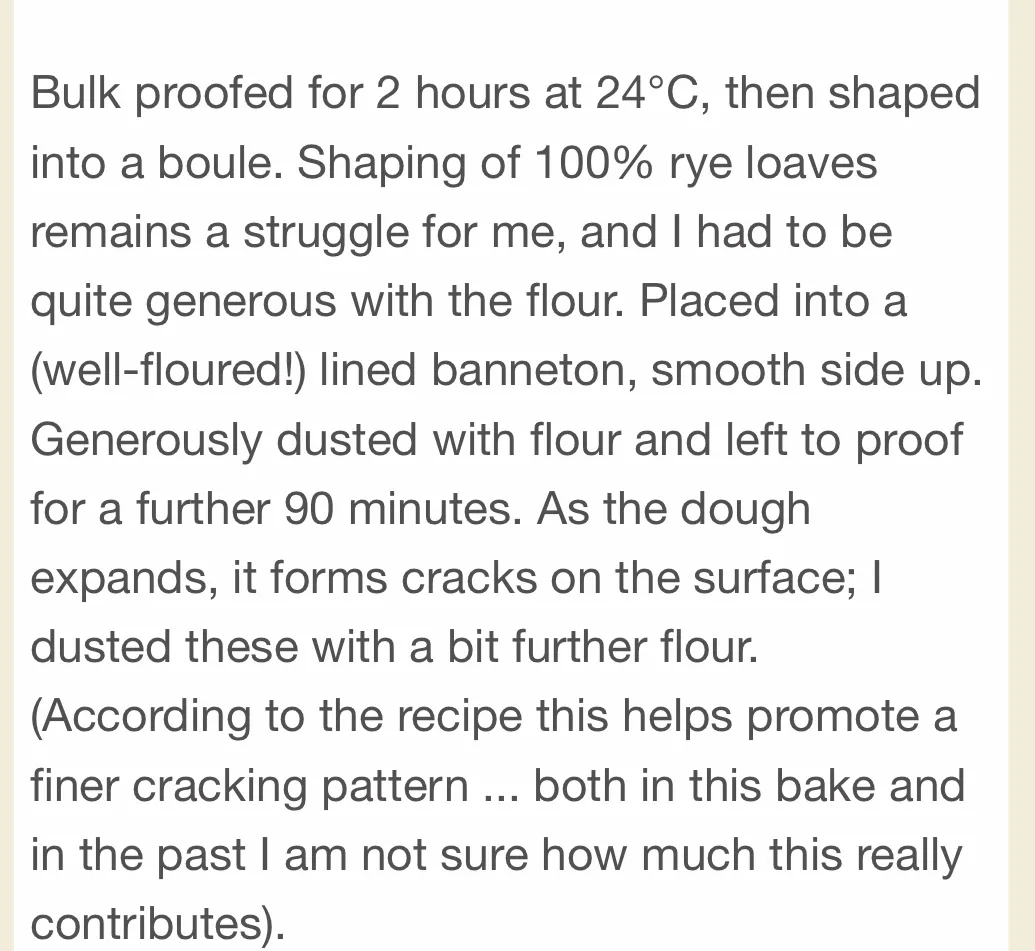
Hey Rob, thanks. This time came out closer to what I'm looking for. I think I was maybe simply underproofed last time:
The two ways I've learned, I find pretty cool. After bulk folding up and forming a boule - very lightly, then directly just rolling into a long sausage, for going into the banneton seam-down. No further shaping from boule into batard, no attempt to tighten a "skin," no real care for the seams being tightly closed. This time, I worked quickly, and was content to let the seam just be a fault line down the length of the dough.
I let it proof farther into crack lengths and depths than I did previously. And a good deal more obvious swelling. I'm wondering if my starter was kind of weak last time - I had to draw my "chef"/Anstellgut off earlier, when it was younger, and I'm wondering if my fermentation run was just weak all along, When the time came, not experienced enough, seeing (smaller) cracks on the surface, I tossed it in, when my better instincts knew it wasn't ready.
The other way I've learned they proof is as you describe, yep, often smoothing on an additional light dusting of flour during proof to encourage cracks. But instead of flippiing it over, which would obviously defeat the purpose, they "throw" the loaf onto the peel with a decisive but balanced flick of the wrist. I'm getting it, and it's fun.
Comparative Schwarzhamster. Not sure if the crumb shot shows it but it's grossly gummy, inedible. You can also see the sunken "valley" on top of the loaf. There were others. I think the use of active rye malt, and the forgetting dry yeast forcing the sourdough to do all the leaving - taking a long time - really jacked the pentosans and the network basically imploded.
The Schwarzhamsterbrot at top looks promising. Different recipe, and I should have realized my tin optimally uses more dough, so the form factor is wrong. Still, I think it should be tasty.
Both look fantastic!
I learn so much from your descriptions.
Cheers!
Rob
Well that's really nice, thanks Rob. I tell you, I've become part of a couple FB pages, one run by Brotdoc, and man it's incredible - a native rye culture. I always did, but makes me appreciate the rye folks here all the more.
Thanks again Abe. This is quite a gift. And your bread leading the whole thing off - I've got the vids up and intend to make it. Gorgeous.
A dull thick crust = over fermented.
A gummy crumb = under fermented.
Your second bake looks far better and looks like it has a crisp bright crust which means the ferment was much improved.
As for the Danish Rugbrod I think slicing thinly and toasting it up might improve it. However in my experience when a bread is gummy and wet it has three days before it begins to get that odd sweet smell which is the beginning of it going off. Unless you can dry it out somehow.
Came across this nice video today. I think you'll really appreciate this method.
https://youtu.be/vi2o3d_YyGg
Thanks Abe, great info to know. The Hamster is something my wife and in-laws love (as do I), but it's my thing to work on one, "foundational" bread for a long time. I fail miserably, lol - this thread alone drives me to try these many different beautiful breads - but I would really like to work on something like Brotdoc's Alpine or one of the Maltkruste-type breads.
Scorched Crust Sour Rye - Gersterbrot (Germany)
The Rye Baker by Stanley Ginsberg
Original blog post
Wow, that's beautiful. I've never tried that one but it sure looked intriguing on my first readthrough. Love to read your thoughts.
My blog about this entry for the Community bake can be found here.
Paul
Okay, so some of you may not have seen my post in the Introductions Thread, but hi, I am David, from Paradise, California! LOL!
I am thrilled to see all of these Recipes for so many different kinds of Breads, Holy Cow! I love Rye and have been just recently getting back into Rye Breads, after doing so many experimental types of French Breads and Sandwich Roll Recipes!
You have found an excellent site with lovely people. Everyone here is willing to share and help each other out. As you can see every so often we have a Community Bake where we all try our hand at the task given. Please look through the ones we've had in the past too. They're always open and great for ideas.
Looking forward to your bakes and if the above photo is anything to go by we're in for a treat.
Thanks so much! I love Forums with great communities, man, and it has been a long time since I have been part of a Community online, outside of Social Media Sites like Face Book. I am in several Baking Groups on Face Book, and it is great to participate in those Groups also, but from what I have been seeing here, this site is stunning, my friend! The information and helpful attitudes of those that I have seen are beyond impressive!
I work full-time and do not usually have a great deal of personal time except for the weekends, so I may not be as active as I would like to, but that doesn't mean I am not going to check in once in a while and see what I am missing..? LOL!
Today I am making a version of a Kalamata No-Knead Olive Bread, only I have substituted some chopped Freeze-Dried Tomatoes instead of Olives. I made it with Olives and it was wonderful, but I like to experiment with Recipes and change things up a bit a lot, and we happen to have some absolutely amazing Sun-Dried Tomatoes! LOL!
I am also making a Blackberry Swirl Cheesecake for my girlfriend to take to work with her, and I am making some Whole Wheat Hot Dog Buns for me to use for lunches at work as well!
Busy day in the kitchen, to say the least, huh? LOL!
Inspired by Econprof's earlier post, I also tried the Sweet Limpa recipe from The Rye Baker. This is a relatively low hydration bread (58% hydration of which 47% is whole milk), but with a generous dose of molasses (18% on flour; I used sugar beet syrup), and a mix of caraway, fennel, anise and coriander to add spice. It makes a very stiff dough, risen with yeast in less than 90 minutes total fermentation time. During shaping the dough was so stiff that I had a hard time getting a smoothly formed surface, manifesting in some cracks in the final loaf (fortunately the inside melded together OK). The bake is relatively low temperature (200C), I had to increase the time vs the books recipe to fully bake (didn't "sound right" and too-low internal temp).
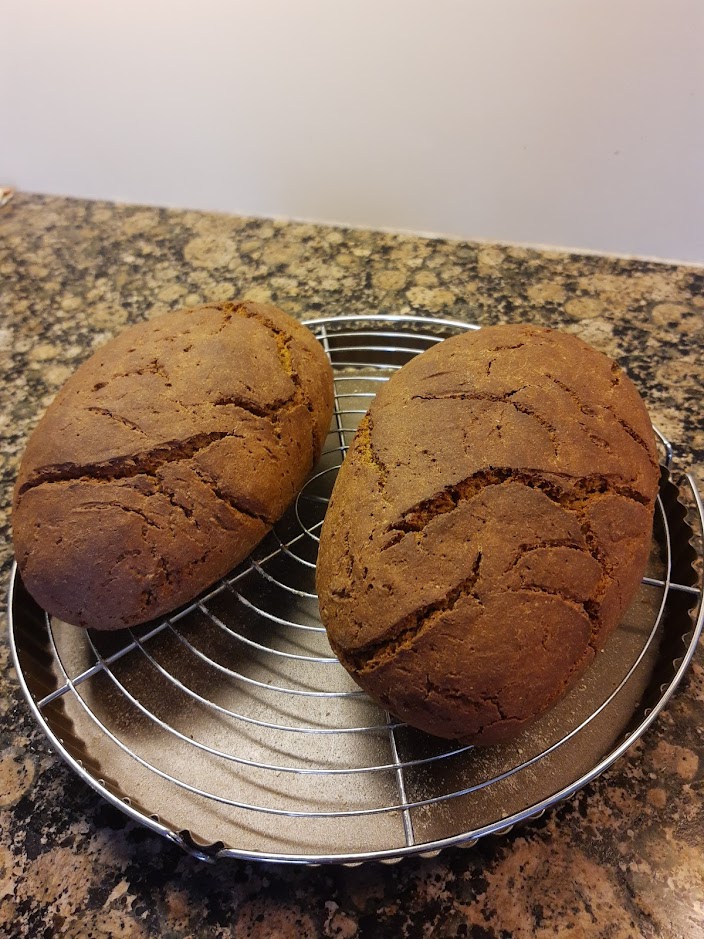
Perhaps it is not a surprise that with all the milk, butter, sugar and spices the end result has a very nice flavor! However the crumb is not only dense, it is also a bit on the dry side texturally - fine when toasted a bit, but would prefer more moistness when eaten plain.
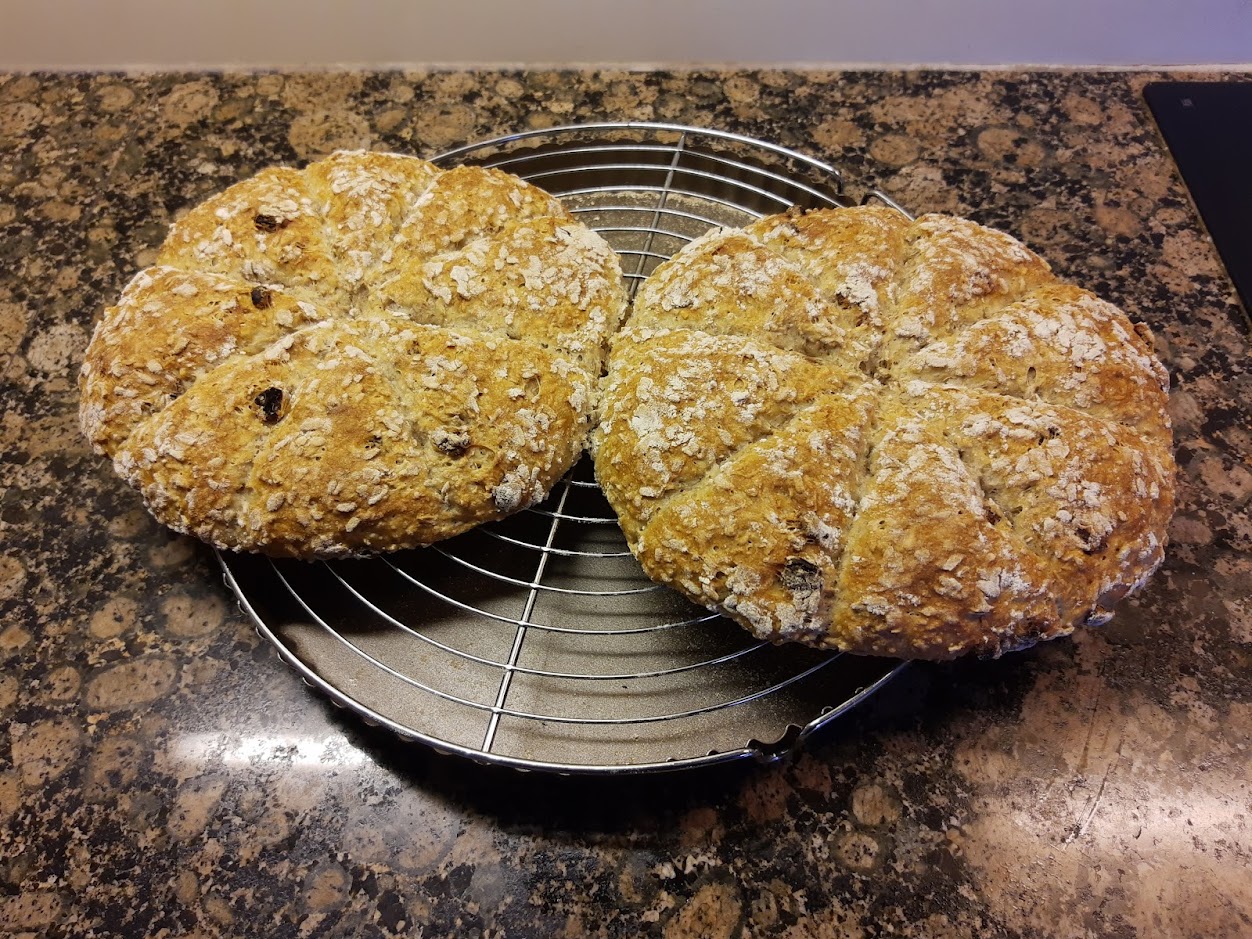
While I had the Rye Baker open, the recipe on the next page for Rye Raisin Scones caught me eye, so I tried that one as well. This one is also a short-fermenting straight dough, 52% rye meal (I used coarse schrot) and 48% bread flour, so it just fits into the CB criteria. With 45% water and 30% milk this made a very wet dough, almost a batter; aside from raisins there is no other sweetener. The final scone has a lot of "crunchy" texture from the rye, but to my taste it lacks sweetness. Thinking about trying it again with a first scald step for the rye meal, or perhaps using boiled whole rye brewers malt as the "filler," to give it some more malty rye character. But as-is a bit of blackberry jam works wonders!
I think your dough may have been slightly drier than mine because of the difficulty shaping, but the crumb looks similar (at least to my untutored eye). Mine was also on the drier side, although I didn’t find it unpleasant to eat plain.
Those scones are beautiful. It’s always nice to have a repertoire of not-too-sweet desserts. I’ll have to give them a try soon.
And i've noticed it differs somewhat from the Limpa recipe on his website which has a slightly higher hydration, 60% liquid from beer before the syrup, but it does look nice.
Those rye scones look marvellous. Begging to be toasted and spread with strawberry jam.
Rye scones look delicious, I’ve never had whole grain scones and I bet they’re great.
Benny
I don’t think anybody has posted a Finnish ring bread, so here’s one I made yesterday. It’s from The Rye Baker book. There is a similar looking bread on The Rye Baker website ( http://theryebaker.com/halme-bakerys-ring-rye-ruisreikaleipa-finland/ ), but it is slightly different because it uses instant yeast as well as sourdough.
Mine looks kind of funny because I didn’t flour the dough (used water to keep the dough from sticking). I don’t know about the flavor or crumb yet because it is still in its resting period.
Image
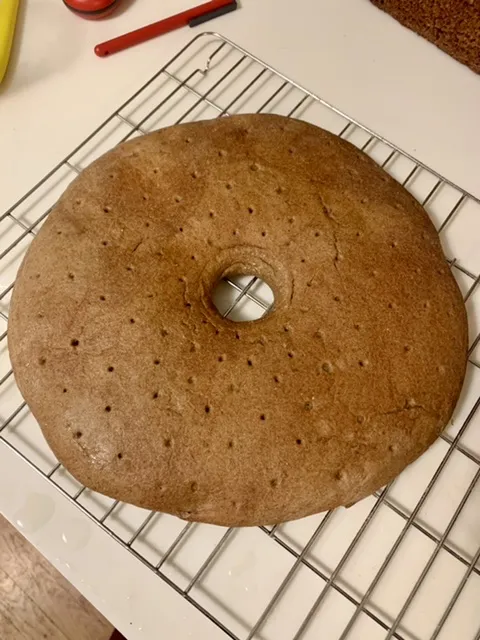
I've noticed his recipes on-line do differ slightly to the same recipes in the book. Wonder if they're just actual variations of the same recipe or if it's purposefully done.
These are the loaves that the Finnish bake and store on a dowel in their homes after baking that last a long time. Nicely done!
Benny
I’ll just freeze it, as I’ve heard that the aged version can be quite chewy, and I don’t think my husband would be up for that!
Keep it away from the mice! They love this bread.
I have made the reikaleipa from Dan Leader's Living Bread, which is a sourdough formulation with an optional instant yeast kicker, but I have not encountered hapanleipa. A search for hapanleipa turned up a few recipes, including one with spelt. Can you clarify the difference between your hapanleipa and a reikaleipa? Is it just the instant yeast?
As far as I can tell, hapanleipa means “sour bread” and reikaleipa means “ring bread.” The one on the Rye Baker website is called reikaleipa, and does contain a little instant yeast. So maybe you are right about the distinction.
this time printed recipe x 1.8 (instead of 1.5) and I found the sweet spot for my pan (holds 2 kilo water) and what a easy recipe after getting the maths done. It is very satisfying to match the 1500g dough to the pan. I went outside to fetch wood near the end of the bake and drooled and danced my way back to the kitchen, no kidding. The aromas were so lovely.
Overnight Prefermint: 270g rye #960, 180g rye sourdough starter, 360g water, 19g salt.
Dough: 360g rye #960 1.5 Tbs crushed coriander or bread spice, 13g orange zest, boiling 270g hot water.
Bake covered 40 min, uncovered for another 20 min. Oven temp 230°C first 20 minutes then reduce to 210° and 200°C. Note: subbed out 100g rye in preferment for wheat all purpose flour. (To get a little more tang.)
Image
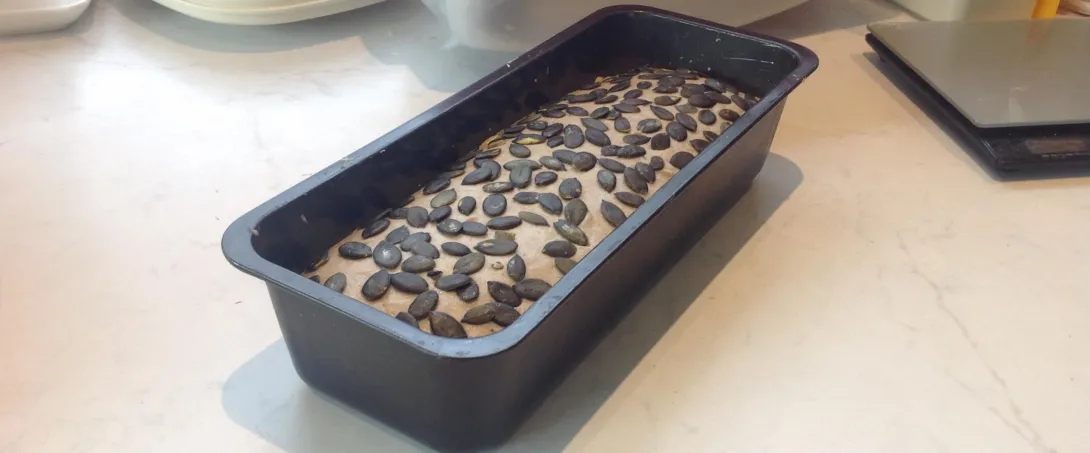
Image
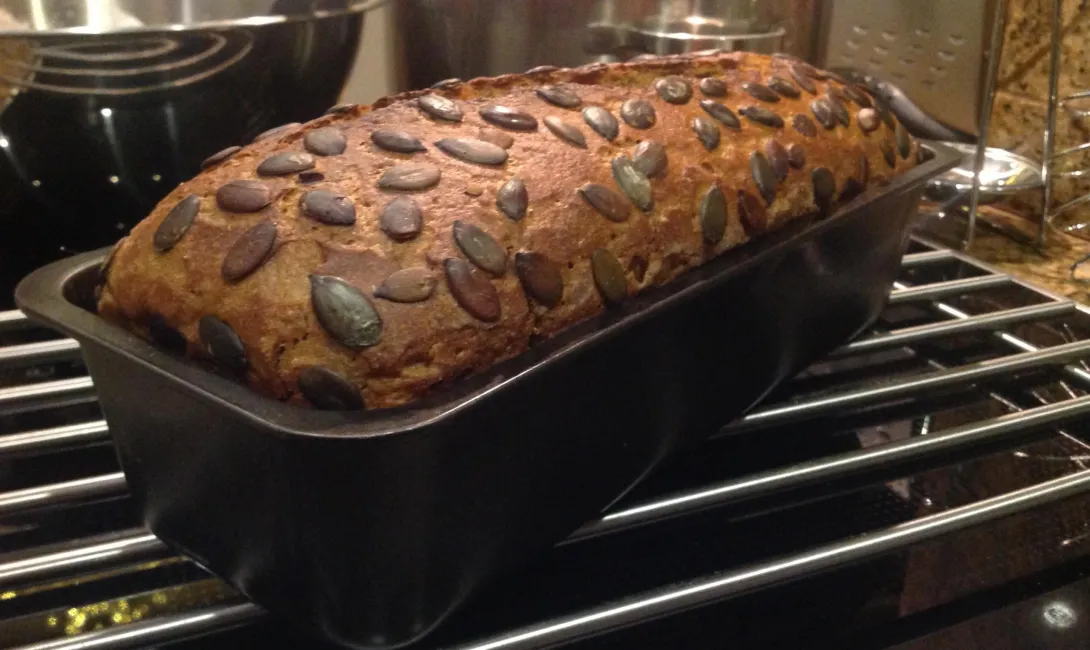
And i'm loving those pumpkin seeds. Hard to beat pumpkin seeds in, or on, a bread. Excellent oven spring which i think beats the first loaf.
Very nice, Mini.
Brava, Mini!!! I'm dancing & drooling just looking at the photos.
My loaf pan is 2 kg also, so I will follow your 1.8 suggestion.
Rob
Rises to the edge of the pan. Funny I didn’t take a picture of it but when it rose that far there was some pin holing and I wanted to get it into the oven pronto. Forgot to dock it too. After the initial 5 hours of cooling, I had to divide the loaf and the crumb looked great under those conditions. No whole grain inclusions this time. Bagged for the night.
Ate a slice with coffee this morning Ein Traum! A dream! Been noticing the ratio pattern in the formula, a fun one. (Go ahead and divide the starter amount into the water and flour separately.)
Crumb is moist, dare I say—soft, and yet firm, even and nicely browned all around. Pan was smeared with salt free butter and pumpkin seeds. This is a keeper. :)
one question, Mini:
Am I correct in understanding that you used type #960 rye flour for the entire recipe? And, again correct me if I'm wrong, this is a light rye?
Thanks.
Rob
My family’s only complaint is that it seams soft or “fluffy.” Baking for four now, us, one post-omicron and one fall injury.
already making the sourdough for the next preferment. You can see the sides starting to curve in as the loaf looses moisture.
Image
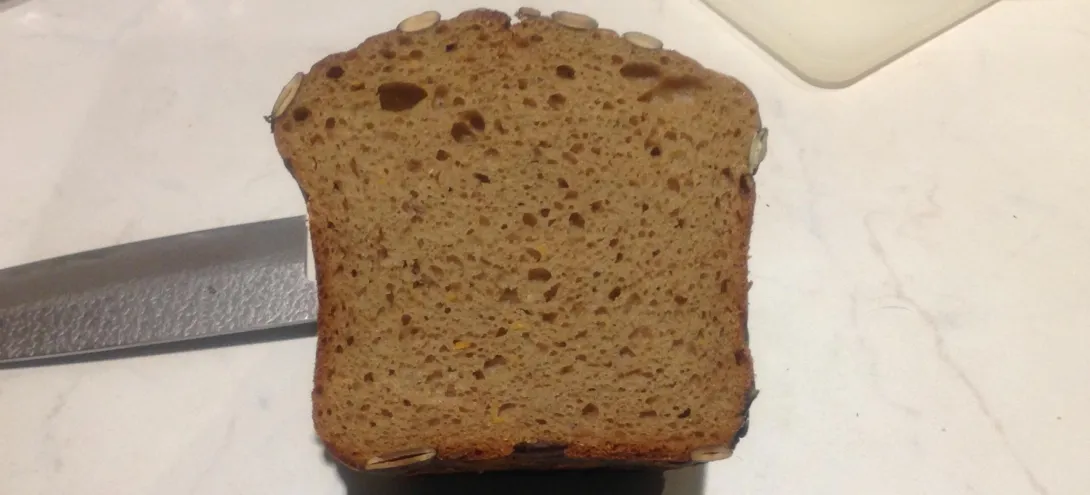
that I substituted 100g rye in the preferment with white AP wheat flour. So not completly 100% rye. I've been reading this entire community bake for the last few hours and getting inspired in so many ways. Will be baking soon when the snow flies again. Great time of the year to bake rye breads. I also have several kilos of tiny fantastic oranges in my fridge. They were greenish colored when I picked them but all turned orange now. I also have two kilos of lebkuchen dough in there and something is about to happen. ???
Look at that spring! Well done, better than the first, if I dare say that!
Gorgeous rise on that bake Mini, hope the crumb is what you desire.
Benny
Very happy with the loaf. Actually hit 100°C inside the loaf. Was a little bit worried about a hollow roof but didn’t happen. Rarely does when the dough is spooned in scoops into the pan. Might have something to do with it. I put the salt in the preferment instead of the main dough, needed 18 hrs until mixing up dough. Thinking that will slow down enzymes and yeast could care less. The preferment was starting to fall when the dough was mixed.
So, your lovely breads made with the boiling water on top of the flour made me try something similar with wheat flour.
What a disaster! It destroyed the gluten, but can't work out if that was from the temp or the hydration.
Of preferment under the flour? Or maybe half the dough? The cool preferment under the flour cools the top flour and water mixture quickly. When I poured the boiling water on top of the spread out flour, it made channels of gel or wet flour. This got stirred with more of the loose flour and then stirred into the cool wet dough underneath. How does that compare? Did you scald all the flour in the recipe?
That's a beautiful loaf, and my mouth is watering. Love the pumpkin seeds! I would love to attempt this (but I am timid). May I ask where you source your rye flours? I can not find any rye of any kind around here (Nashville area). I have 2 bags of Arrowhead Mills whole grain rye in the freezer that a friend brought me from a store in Florida because Whole Foods here has been out forever. I found a place called Carolina Ground in Asheville, NC (my daughter lives there and I visit periodically) that has "Wren’s Abruzzi Rye milled and/or sifted to various degrees", but they are currently out of stock. Maybe it's temporary. I am new to artisan bread, sourdough, and rye flour (except for a yeasted rye bread recipe I use that is 1/3 rye flour, 1/3 bread flour, 1/3 semolina). But I am trying to learn all I can!
I see now you are in Austria: no wonder you have fabulous access to rye grains/ flours. I should have paid attention before I asked. I was an exchange student there back in the dark ages, in Horn and Altausee. Even as a teenager, I was blown away by the fabulous dark breads we had for breakfast and with our evening suppers. I gained 20 pounds! I am new here and love seeing your breads and reading your posts.
This looks fantastic. It would be hard to do better. I have not tried a light rye flour yet, but it is interesting to see what it can do (in the right hands). I will have to try bolting some rye. It is much softer than the hard wheat I usually mill, and I am curious how well the bran separates.
I'd be using your flour. Seriously!
One dude's accounting, just today. Not a reliable source, but he seems earnest.
I do not have lot of experience with artisan bread and have never used 50% rye, so I decided to use Eric’s recipe that’s posted here for the community bake. I am also brand spanking new to sourdough, so I used the yeast version of this recipe (I did make my first ever sourdough starter last night using the “pineapple juice solution.” If it doesn’t work, I’ll toss it and order some online.)
I just joined TFL a week ago, and I am amazed and impressed at such knowledge and talent here! I check this community bake topic daily just to see what’s been added and I am blown away. I have read every comment. I was a little timid to post this given I didn’t come up with something new to offer, but I’m a beginner artisan baker, so I decided what the heck. I am pretty pleased with my simple beginner loaf, but I know it's not perfect (but oh my, the taste is fantastic with the seeds, orange peel, and molasses!), and I do have so many questions that I could not find answers to.
First, Eric said he used “very strong bread flour.” I only had regular KA bread flour, so I added 1.5 tsp of vital wheat gluten (thinking that would create “very strong” bread flour. I couldn't find anything on how to "make" very strong bread flour. My house can be pretty cool in the winter, like 68 and less, but I had one spot that’s 70-72, so that’s where I did the proofing. Overnight it rose quite a bit more than I expected, but not too crazy. This morning, I shaped my loaf and put it seam-side up in a linen-lined bowl.
I know I should watch the dough, not the clock. But Eric’s time in the proofing basket was 1-1.5 hours. So I set my timer for 30 minutes to check on the dough and also preheat the oven. Look what I found after 30 minutes! That looked way more proofed than the video. It looked nothing like Eric’s basket-proofed dough. I stuck my floured finger in it and the dent did not rebound — and my oven had only just started to preheat. I knew it would take at least 30 minutes, so I stuck the dough in the fridge. Did my dough rise so quickly because I added the vital wheat gluten? Is the finger poke test even appropriate for this 50% rye dough? Does it look over-proofed? And if so, was putting in the fridge to retard further rising the right call?
(After only 30 minutes)
Image
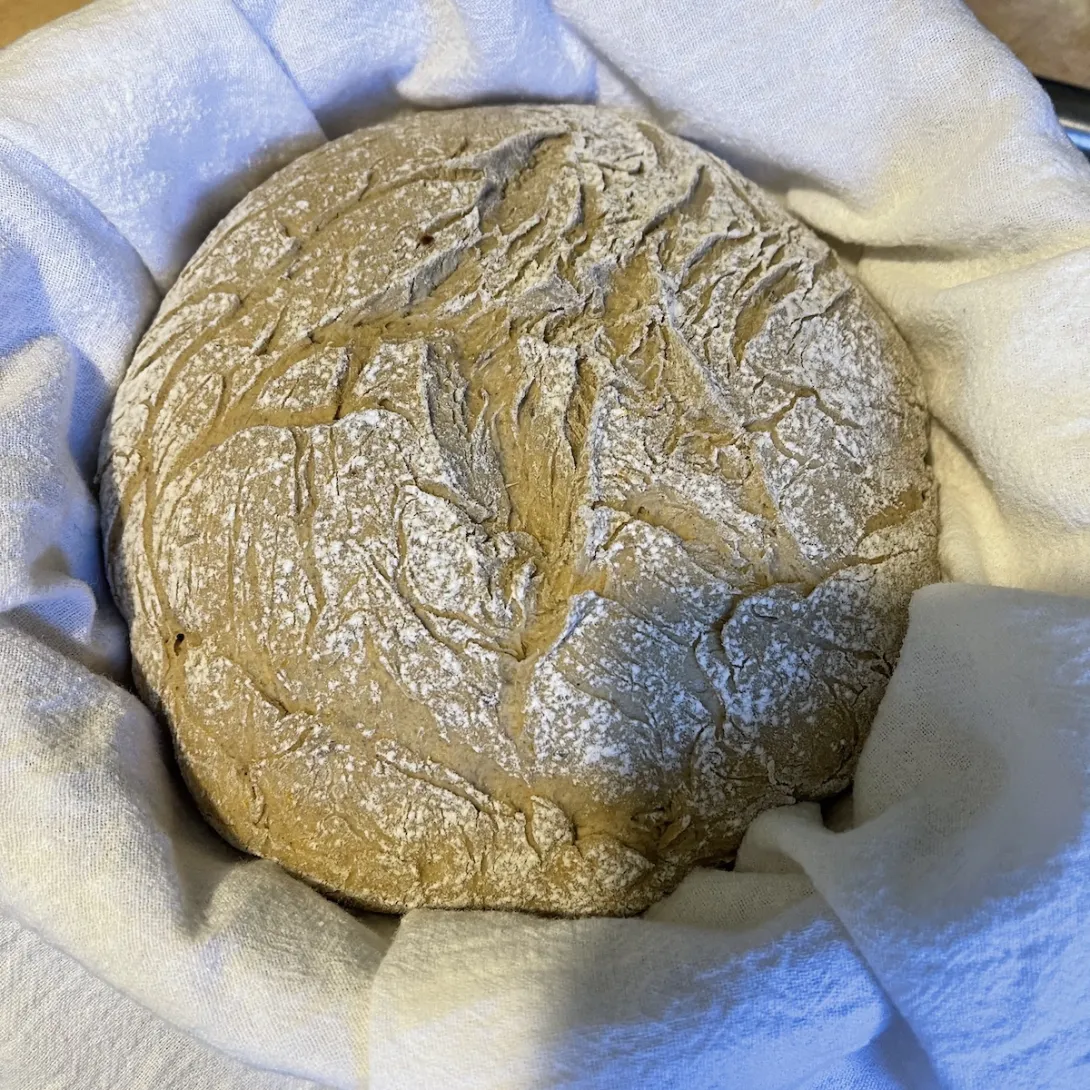
I made a parchment sling because I don’t have fancy oven gloves and I tend to burn myself under far less dangerous circumstances. I think I didn’t slash deep enough (the dough was in the hot DO when I slashed, but without the fancy gloves, the heat from the oven was burning my hands. (I immediately ordered the gloves from Amazon, so I’ll be prepared next time!) That brings me to the question: how deep to slash? I used a curved lame. Is that the best choice for this kind of bread?
Other than adding the vital wheat gluten, I followed the recipe, measuring everything carefully by weight (except yeast and gluten flour were by volume). I think I watched the videos 6 times! I also used a thermometer with an air probe to monitor oven temp, so at least I know that was right. I took the loaf out at exactly 200 degrees F. And I cut into it after 1 hour, which is what Eric did in the video. I shouldn’t have cut into it that soon (I know better); it says "cool completely in the recipe," but I was following the video. I placed it cut side down on the cutting board to hopefully salvage things. Overall, I am happy. The loaf has a fabulous flavor. It doesn’t feel gummy or dense, but it looks denser/tighter (fewer holes) than Eric’s and others posted here. Which makes me wonder if it was not on the verge of over-proof after all (or even under) and I should have not refrigerated while the oven pre-heated?
Thank you in advance for any feedback, critique, and tips!
For a 50% rye I think you have had an excellent rise on par with Eris's bread. Very nice even crumb and a lovely crust. What do you think of the taste?
Thank you for your kind feedback. The taste is DIVINE. I think my cousin who hates fennel will even like it. About to find out! The combination of flavors is such that not any one flavor overpowers. It's a lovely bread taste-wise. I wish my loaf had more of an open crumb, like others I've seen, but the texture doesn't offend me when I eat it. I will make this often, I think, but I will branch out and try different rye breads now. So many great ideas here.
To me, that does not look over-proofed at all! LOL! That looks really good, and if the taste was spot-on, then you have a winner there!
Ha, thanks! It does taste great. I’ve got so much to learn, but glad I jumped into this community bake to get my feet wet. I’ve got my sourdough starter going, fingers crossed.
Beautiful loaf! Fermentation looks good from what I can see in the photos. Think you're going to fit in just fine here!
Thank you! But you know how sometimes the more you learn, the more difficult things can get? Lol. I know sourdough will much more challenging but I’ve got my starter going and I’m up for it! It will be interesting to try this same recipe with the sourdough starter.
Nice home run on your first bake posted on TFL, a big welcome to you. I don’t think it’s over fermented at all. I look forward to seeing more of your baking!
Benny
Thank you! This is a first for using this much rye flour and I think it's just wonderful. I'm hooked and can't wait to try more of these incredible, yet above-my skill-level, recipes that I am seeing here at TFL. I can only aspire to such lofty goals!
NICE JOB!
Thank you! You are all so kind. :)
Made Stan's recipe for the first time last week. Amazing flavor, slightly sweet, malty and a nice subtle tang of sour. I used whole rye since I grind my own berries. I also made my own rye malt a few months ago. I spend a week making my own rye starter, then assembled the bread as outlined (first day am, then pm add, then day 2 morning assembling, rising and baking that afternoon after a 3 1/2 hour rise. Fabulous, will make again. The only other change is to shorted the bake time by 5 minutes and to double the recipe next time to get two loaves! Very worth bread, thanks Stan and your Rye Baker book!!
Nick
That loaf looks superb Nick, very well fermented.
Benny
That's how google translate renders 'awe inspiring' in Lithuanian. I want to try making this. Is there a difference between the book recipe and the one on The Rye Baker site?
Rob
That's beautiful Nick - I find this type not easy to do, and yours looks awesome.
Beautiful bake! I made this a few weeks ago (before the Rye CB) and I was blown away by the flavor. Your bake looks a lot better than mine. You say you proofed for 3.5 hours. Did you follow Ginsberg's instructions for a 1.5× rise? I did the 1.5× rise using an aliquot jar and I think mine was under-proofed at 2 hours.
Thanks for your comments! I did use a jar to monitor the rise. Stan's recipe says 2-3 hours but mine peaked closer to 3.5 hrs. I actually could have let it go 4 hours as I had a slight 1/4" wide tear across the full side of the loaf near the bottom - which indicates under proofing and just visible in the slice, left side of the photo. That said, the tear was relatively minor and near the surface of the dough.
My bigger flaw was the loaf was slightly overbaked by about 5 minutes as stated in the post. Thus next time i bake this, the last phase would go 18-20 minutes rather than 25 per the recipe - or use a probe thermometer to end up at 201 degrees vs what actually was 209 based on my too late insertion of the probe. I would also try to shape the loaf so the ends did not taper as much as that is where the drier parts were, not surprising given the ending probe temperature. Also, my original post omitted two additions: Charnushka seeds and fresh ground coriander in the dough, added in the final dough stage. A touch of molasses rather than the called for 25g of sugar would be interesting too. Hope this helps!
All a great bread nonetheless as the flaw was mine, not the recipe!!
4th rye bake overall. 3rd one submitted to the CB. 2nd one made with all home-milled rye. 1st with a scald.
https://www.thefreshloaf.com/node/69889/84th-bake-020422-denisas-100-rye-take-4
This one hit the spot!
The previous one with "Vitamixed" flour seemed like the larger particles (the Vitamix does not make uniform particle sizes, some are powdery, some are gritty) did not get fully hydrated/softened. So I tried a scald, and let it soak/cool for 3 hours.
This came out moist and sweet.
Dave that looks great, do you think that the cracking indicates a bit of under fermentation?
I terminated final proof when I saw 4 pinholes. Maybe I should have waited for a few more.
This being freshly ground flour, I was afraid of over-proofing.
I think the scald also contributed to oven rise, as it gelatinizes the starch and lets it hold expanding gas better. Can one of the rye experts confirm that please?
In Denisa's (HungryShots) video, her bread has a little epansion in the oven, but shrinks back before the bake is over. My two previous loaves had a little visible shrinkage.
Regardless, this bread reminds me of some mystical bread from my childhood -- it triggers something. And I feel like "this is it -- this is the rye bread that I'm looking for."
I like the crumb, its texture, density, moisture level, and mouth feel. I like the taste.
.
Looking close at the crumb, the loaf did very well. Good all around crust color and crumb, no hollows or dense areas. Yup, you done good!
I think that your surmise about letting it ferment just a few minutes more is on point but, like you, I want to get it into the oven once those pinholes show up.
Paul
There are so many inspiring rye breads here, and I'm accumulating lots of bookmarks for future bakes. It is hard to keep up.
I attempted the Westaphalia Pumpernickel from the breadandginger.com site. This is documented in more detail in my blog [HERE]. My oven isn't working right now, so this long slow pumpernickel bake seemed like it would be a good candidate for the the multi-cooker, which I'm comfortable running overnight. It reminded me somewhat of the Icelandic Lava Bread posted above by Abe. It seems promising so far, but I will wait a couple of days before slicing into it.
A neat idea in the way you baked those and they look like they've turned out very well indeed! Really good to know it works out so well in a slow cooker.
Very nicely done.
reminds me of https://www.hefe-und-mehr.de/en/2018/06/rye-bread-in-a-jar/
I'm eager to hear tasting notes.
Paul
This looks like a great candidate for a bread to mail to family and friends.
Great us of a multi cooker David, those look really great. Can’t wait to see the crumb and here what the flavor is like.
Benny
I'm very curious how they turned out, and will post an update in a day or so. I love the jar story, and these really do lend themselves to mail delivery for friends and family -- assuming the crumb and taste warrant it. I'd have to repeat this a couple of times to have enough confidence in the process to send one.
Here is a picture of the crumb after a couple of days of cooling, although crumb is probably a misnomer. I have little to compare this to, but it reminds me somewhat of black licorice. I don't have much of a sweet tooth, and while this bread isn't overpoweringly sweet, I think I would cut the syrup in half for the next one. It looks fairly close to the photos associated with the [recipe], but I welcome comments from anyone familiar with this. Truth be told, I'm happy to have this first attempt anywhere in the ballpark. I don't know if there were any adverse affects from cooking under pressure. It is a dense bread, but it slices fairly easily. It doesn't feel gummy, but the knife doesn't come out 100% clean either.
That looks pretty much spot on. Might be slight variations in colour depending on recipe and syrups used but the crumb and structure is that of a Pumpernickel.
Very nicely done.
That looks very much like I would expect for this style of bread. You have a winner!
Paul
Third the motion. :)
Just ordered myself some appropriate jars so I can try it :)
Gave it a try. My jars were on the small side, so I got 5 mini loaves. Looking forward to cutting into it!
Those are awesome. Congratulations, can't to read your notes once you taste them.
Edit: Missed your second post. From my admittedly less experienced eye, that looks spot on to me and delicious.
Smart way to bake David. This might influence your baking style for years to come too.
Reminiscent of Boston Brown Bread, in appearance and cooking method.
Westfalen-Kruste – Westphalia-Crust, by Brotdoc (Björn Hollsteiner). I really like these rounds with the seams proofed down and opened in the oven. Still working on technique to get many, narrower cracks, which I find beautiful.
Followed his formula exactly, with the exception that for the Aromastück he calls for "mashing" the rye porridge at 65 C for 2 hours, I mashed slightly higher (for a higher a-amylase activity) for 4 hours as it's not easy for me to stir once the step starts its hot rest (a water bath, for me). At the end of the step I also brought the Aromastück to 71 C and maintained it for 30 minutes, just to ensure the amylases were disactivated and the a-amylase and b-amylases were "set" as they "mashed." He doesn't do such a step. Probably unnecessary, just a holdover from brewing days.
And from reading the recipe, it sounds as though it is probably very flavorful, too.
Paul
Thank you Paul, always very much appreciated.
Beautiful looking and appreciate all your variations of rye for this community bake. How was the crumb and taste?
I've been a good boy with these ryes, new for me to show some patience - snoozing cozy wrapped in linen for another day. I'll be sure to post. Thanks!
Wow. Looks as good as the loaf on the cover of Hamelman's 3rd edition of Bread.
! Wow, thanks Dave. I hadn't realized this was the type of bread he did for the cover of the 3rd. As a side note, do you think the third adds quite a bit to the 2nd?
Gavinc did a comparison chart of which recipes are in the 2nd and 3rd editions of Hamelman.
https://www.thefreshloaf.com/node/68660/lost-recipies-hamelmans-bread#comment-491322
--
I have the 1st editon. Right now, a new 3rd edition (at $35 + change) is cheaper than the used price of a 2nd edition. But I'm cheap, and will get the 3rd edition when the new or used price drops to $25 including shipping. Or, if the used price of the 2nd ed falls to $15 including shipping, I might get it instead.
Like you, I have tended to go overboard buying books my whole life. Insisting on bargains with used books seems to stem my spending a bit.
To tie it into rye, to keep it on topic, I've been tempted to get Ginsberg's The Rye Baker, but with the proliferation of rye blogs -- theryebaker, rusbrot, ploetzblog, brotdoc, etc. -- I just keep reminding myself that recipes are mostly free these days, and the temptation to buy another book is held at bay.
Whoops, don't know how I missed this, sorry Dave. You're a better man than me in terms of control - I'm ridiculous but believe it or not, for the first time, I'm actually selling off a ton of cookbooks. Hundreds, and many of them I haven't even read. More room for the German books - when they drop in price.
Thanks for the info. I like Stanley's book but agree, there's so many sources out there. I'm constantly on Brotdoc and ploetzblog, as well as a couple of FB communities, one a community of German/Austrian bakers.
Cheers for the reply, thanks.
That is a great looking loaf of bread, and a very close match to the photo from the recipe. I'll bet it tastes good too. I can see one of these with a blue and green color scheme for a planet earth effect.
4th submisson. Pretty much same as previous. Levain was left to ferment 9 hours instead of 8, and got a better rise during final proof.
https://www.thefreshloaf.com/node/69937/85th-bake-02082022-denisas-100-rye-take-5
Impressed at your perseverance, four times in a row with the same recipe!
this much when I was first learning sourdough, instead of bopping all over the place. I guess that was my ADD.
It seems like I've now switched to OCD mode. Which is good, because rye is such a different animal, and requires it's own learning curve.
I haven't filled in my recent blog posts on rye with all the details yet. But some of the things I've learned:
Good notes Dave, thanks for sharing them. I am not sure if I am a rye bread type but there are so many interesting things about rye baking here for me to take notes.
That looks delicious, Dave. Really, really good.
It is nice to see the evolution of this one. I've read about your multi-step milling process. What does the final coarse rye flour look like?
Ack. I keep forgetting to take pictures of the final flour product. I'll add them on my "Adventures in milling" blog post. Unfortunately, I've used up my store-bought stone-ground rye for a side-by-side comparison.
Lithuanian rye :https://solnce-pek.livejournal.com/11724.html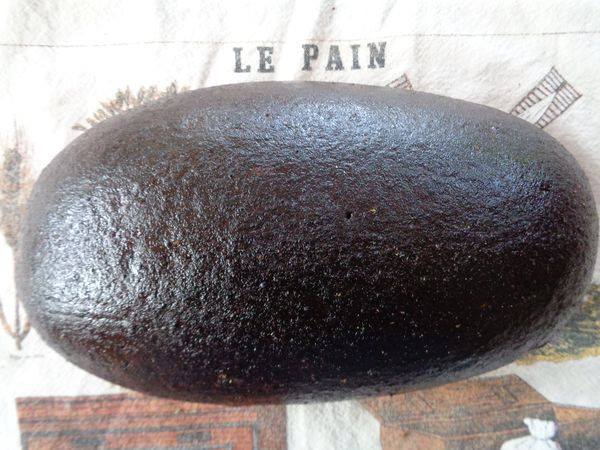
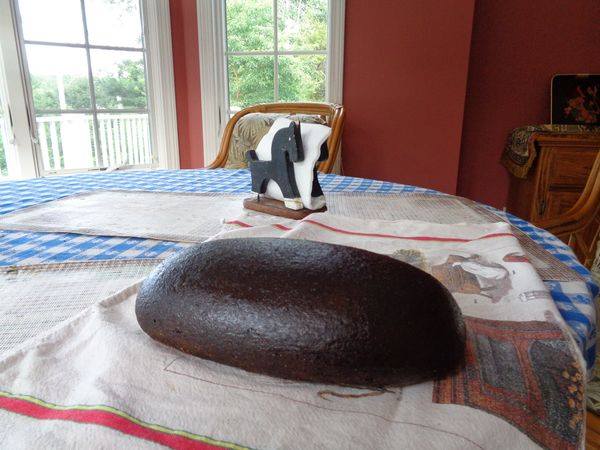
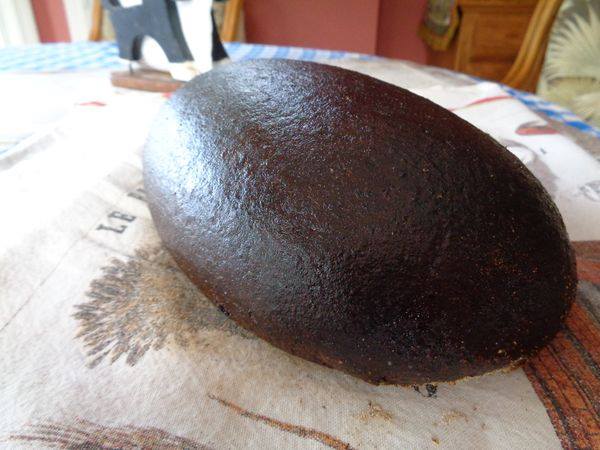
The first is that 3 days after baking , the flavor comes out and it tastes like cherries.
all flour is wholegrain rye except where noted as red and white rye and wheat. Red rye is fermented rye malt and if you don't have it, you can use crystal malt--but it is definitely not the same. White malt is diastatically active malted rye and as I note, you can use wholegrain rye instead.
Notes on Lithuanian
Levain
20g rye starter
100g water
100g rye
Mix and ferment for 10-12 hours at 84 degrees F
Scald
220g rye flour
10g caraway
23g rye malt(red)
330 g water, boiling
10g white rye or wholegrain rye.
Pour boiling water over 220g rye, 22g red malt and 10g ground caraway.
Stir like a crazy person. When it reaches 150degrees F, stir in 10g white malt.
If it is lower than 140, make sure you heat it up to 150 before adding white malt.
Over 140 degrees F is to denature sticky enzyme.
(Heat up method)Or put everything in a pan and heat up to 150 F and add white malt.
Then in either case hold at 150 degrees F for at least 2 hours. It will turn sweet and slacker, but it is very thick.
Cool scald to 90 degrees F before proceeding.
Preferment:
Measure out 550g of cooled scald and add to it 200g of Levain or use all of 220 g .
Hold at 80+ degrees F for 12 hours or 8 hours at 85 degrees F. It will get soft and swell.
Final Mix
All preferment
120g wheat flour(I used whole grain wheat)
150g of rye flour
1 tablespoon sugar
1 tablespoon honey or sorghum syrup
8g salt
Knead final dough by hand and it should be like soft , warm clay, not very sticky. Squeeze the dough through your hands.
Form and reform until it feels right hydration that you can form it later.
If not, add flour or water so it is just right texture. I probably spend 5-10 minutes until it feels good.Keep warm at 84 degrees F for 2 hours and it doubles but not falling apart.
Holes on the surface. Then wet moulding of dough and smooth, no seams anywhere. Not even on the bottom. Keep warm for 30 minutes and when pinholes appear on the surface—8 or 10 holes-coat with paste made of 25g leftover dough and 25g water and throw in hot oven. I use 500 degrees F with convection on a pizza stone--uncovered. Bake for 10 minutes at 500 degrees F, then open oven and cool it down to 450 or so for another 40 minutes. Check for doneness and spray with water and leave in 3 minutes . Take out and coat with cooked mix of 5g starch and 150g water that you made before and cooled down. I use potato starch.
I had to translate using DeepL, so got some strange words. Could you help?
In stage 1 sour, is that 200g whole rye? (I get "wallpaper rye."), 10 g cumin, tbsp solod, 300 g boiling water;
For:
Опара ( заквашенная заварка)
вся заварка
1 ст. освеженной ржаной закваски - 200г
Оставить для брожения в закрытой емкости на 12 часов.
I'm getting:
Opara (fermented tea leaves)
all tea leaves
1 tbsp. fresh rye sourdough - 200g
Leave for fermentation in a closed container for 12 hours.
I think I recall RusBrot discussing the tea leaves somewhere, but can't recall much about it. Can these leaves be subbed in somehow? Do you have a procedure you wouldn't mind describing?
For the main dough:
Dough
whole dough
1 tbsp. rye wallpaper flour - 100g
1 tbsp. wheat flour (I took grade 1) - 120g
2-3 tbsp sugar - 35g
1 tbsp honey - 35g
2tsp salt - 15g
1-2 tsp barley malt extract (not necessary, this is my addition)
-the "wallpaper" flour - is this again whole rye flour?
-Wheat type "1." I can't recall the Russian grade, but I recall a discussion of trying to sub with an American flour. I seem to recall RusBrot saying first clear is OK, but - I think - it was suave, maybe, who said that's not really a sub, as they are different not only in degree, but in kind? Could you recommend a sub for this wheat flour?
Many thanks again.
all flour is wholegrain rye except where noted as red and white rye and wheat. Red rye is fermented rye malt and if you don't have it, you can use crystal malt--but it is definitely not the same. White malt is diastatically active malted rye and as I note, you can use wholegrain rye instead.
Notes on Lithuanian
Levain
20g rye starter
100g water
100g rye
Mix and ferment for 10-12 hours at 84 degrees F
Scald
220g rye flour
10g caraway
23g rye malt(red)
330 g water, boiling
10g white rye or wholegrain rye.
Pour boiling water over 220g rye, 22g red malt and 10g ground caraway.
Stir like a crazy person. When it reaches 150degrees F, stir in 10g white malt.
If it is lower than 140, make sure you heat it up to 150 before adding white malt.
Over 140 degrees F is to denature sticky enzyme.
(Heat up method)Or put everything in a pan and heat up to 150 F and add white malt.
Then in either case hold at 150 degrees F for at least 2 hours. It will turn sweet and slacker, but it is very thick.
Cool scald to 90 degrees F before proceeding.
Preferment:
Measure out 550g of cooled scald and add to it 200g of Levain or use all of 220 g .
Hold at 80+ degrees F for 12 hours or 8 hours at 85 degrees F. It will get soft and swell.
Final Mix
All preferment
120g wheat flour
150g of rye flour
1 tablespoon sugar
1 tablespoon honey or sorghum syrup
8g salt
Knead final dough by hand and it should be like soft , warm clay, not very sticky. Squeeze the dough through your hands.
Form and reform until it feels right hydration that you can form it later.
If not, add flour or water so it is just right texture. I probably spend 5-10 minutes until it feels good.Keep warm at 84 degrees F for 2 hours and it doubles but not falling apart.
Holes on the surface. Then wet moulding of dough and smooth, no seams anywhere. Not even on the bottom. Keep warm for 30 minutes and when pinholes appear on the surface—8 or 10 holes-coat with paste made of 25g leftover dough and 25g water and throw in hot oven. I use 500 degrees F with convection on a pizza stone--uncovered. Bake for 10 minutes at 500 degrees F, then open oven and cool it down to 450 or so for another 40 minutes. Check for doneness and spray with water and leave in 3 minutes . Take out and coat with cooked mix of 5g starch and 150g water that you made before and cooled down. I use potato starch.
Wow! That is one a beautiful loaf. I would love to try this one but I'm having the same translation issue that Gadjowheaty is having.
See my notes above-I will amend the post to include my notes.
Thanks George! Just a few questions.
"White malt" - I simply mill standard rye malt to flour as one would use in brewing. This is what you're talking about, yes?
I'm interested in this thing about "fermented tea leaves" and think I saw RusBrot discussing it somewhere, but I'm not certain. Do you have any comments on this portion of the formula?
This is a question I've wondered but don't have an answer to, perhaps yourself, mariana, Ilya, suave or another might have a thought. In baking I often see this figure of 149-150F when wanting to convert starches to sugars by amylase enzymes found in malt. b-amylases are active from about 140-149F, optimally, and quickly denature at higher temps. These enzymes act like little "nibblers" as they break sugars away from the end of starch chains. In brewing, these amylases give you the greatest amount of simple sugars, i.e., fermentables - and therefore alcohol - as you're going to get from a given grain blend.
A-amylase works much more randomly - "chomps" like a crazy person anywhere - creating unfermentable dextrins as well as maltose, etc. Big pile of sugary and dextrinous mashup. In beer, some (like myself) like it for perceived mouthfeel and richness.
Is it the case that in baking, you get no relative benefit from some of the things a-amylase can give us, so you want as much simple sugars as you can get and therefore always go to the b-amylase range? Is this why 65C/149F is always used?
I think alpha-amylases are quite active at 65C too. From what I understand, dough benefits from both simple sugars and dextrins, so perhaps around 65 is optimal for a balanced result.
Yep, agreed, they are active at 65C. They're just much more active higher, 70C-74, and at that temp you're quickly losing b-amylase.
That's good to know dextrins aren't lost in the overall quality of the bread. Do you happen to have any source material you could suggest on any of this stuff? So perhaps a question I might have is what happens if you develop a dextrin-rich and simple sugar-poor (comparatively speaking, an extreme hypothetical) malt stage? Residual sweetness as a deliberate choice, and secondly, is there anything that would exceed a sensory threshold (i.e., in beer, by-products with a high-enough molecular weight to be perceived....hard for me to imagine such a threshold can be surpassed, given bread is such a different medium - but it would be cool to know if so)?
My "go-to" for a nice balance of both in British style ales was a bit higher than 65C, 66.5-68 C.
Since mariana replied as well, I'll defer to her authority and direct you to her :)
Thanks for the help, Ilya. George's bread looks amazing and I'm really eager to try it.
And thank you again mariana.
You are right, I have only had time to quickly look through the recent posts and not comment much the last few days - the bread looks excellent, and indeed a very typical Baltic rye. All water in the scald (and some in the starter of course), those are nice style of breads! Must be delicious.
I just realized, this and the one I most recently made were noted as "Lithuanian" ryes, which seem to share a good deal with the "Riga" and "Latvian" ryes I've come across. I would have to believe as is human nature (for fun, gather cooks from Toulouse, Castelnaudary and Carcassonne and say the other told you they make the "authentic" cassoulet. Then back away and watch the mayhem).
Are their unique aspects of each of these that mark them as "Lithuanian" or "Latvian?"
Paul, here are some answers to your questions
Type 1 flour - unbleached bread flour in type 55(0)-65(0) ash range.
White malt - diastatic rye or barley malt, milled
Fermented "tea leaves" - fermented scald. In Russian, scalded tea leaves, prepared as part of Russian tea ceremony, are called заварка (scald), the same word as "scald" in scalded portion of bread flour in the bread formula, hence the mistake in machine translation.
65C is used because it was determined experimentally as optimal temperature both for liquefying the scald (initially, it is of rather thick consistency) and starch breakdown.
It is assumed, that 65C is the initial t only, with time, by the end of the third hour, or longer, it would decline to 55C and even 45C to complete full breakdown of starches of the scald into sugars at the optimal for beta amylase temperatures.
Best wishes,
m.
Perfect, thank you mariana!
Thank you in addition for the bit of lore on the "tea" mis-translation. Don't know if I ever mentioned it but I once played Константин Станиславский,the one-time director of МХАТ, in a play called "Chekhov in Yalta." Something of the samovar figured in the piece and I've always wanted to do a true Russian service since. In Chicago there is a Russian Tea Time restaurant which by all accounts is nicely authentic. We plan to visit Chicago in the spring and hope to make a visit to the Room.
thank you mariana-
I use malted rye which is diastatically active, not barley malt. ...You could have the "tea leaves" at a higher temperature than 65C and it would give you a different flavor and you could find that better for you. In this bread what is remarkable is that 50% of the total rye is in the scald and 70% of the rye is prefermented. These two factors distinguish this Lithuanian Rye recipes from others, which have the scald much smaller or only scald the red rye. These differences translate into different flavor bread. When you make it, you'll find fruit flavors(like cherries) appear 3 days after baking and they keep changing.
Thank you George, can't wait. I have whole rye malt, that I just mill as needed into flour. This is a fantastic bread - thank you so much for the inspiration.
There are a few things to be careful of. The first is that when you make the scald add in white rye after it is around 150F-if too high, it will denature some of the enzymes. Do not be afraid to let it go more than 2 or 3 hours, I've held it to around 5 hours and let it cool down over night and you can do it ahead of time and put in fridge. You may need extra scald as you'll lose part in the pans-I assume 10% loss and I can't remember if I built in that 10% or not. The preferment does need to go that long when you taste it the next morning you'll want to grab and spoon and dig in! The fermentation goes fast in many cases the second rise is half the time of the first and the first is short. So, watch it and you'll see it swell up in front of your eyes. So , have the oven hot before you start the second rise. Good luck and have fun-it is a dough that is just full of life!!
Thanks George. The window would be 140-160 or so, but yes at the higher temps the b-amylase would be denatured quickly and you'd end up with less fermentable sugars. I like and get what mariana had to say about the b-amylase range. I actually don't do a dropping temperature but maintain the scald in the saccharification range for anywhere from 2-4 hours, even more. Just looked at the last beer I brewed, few years ago.** I see that my mashing schedule was a mashing in at 145 for an hour, ramping up over 10 minutes to 158 and holding for 20 minutes, and mashing out at 170 and holding for 15 minutes. At 158 saccharification can be complete at 20 minutes. Doesn't mean complete conversion but enough that iodine shows no starch remains. Typically I was always around an hour for whatever main temp I was using.
Good note too on being ready with the oven! I've been surprised by a couple rye bakes and ever since I have the oven on plenty early in the process.
Thanks again for all this. It's a wonderful bread, I can tell, and you baked it so beautifully.
**It was a beer commissioned by my son for his graduation party; we brewed it together. A sort of hybrid American-British strong bitter, photo below.
You are a pro with using a mash--that is for sure and what a beautiful beer! I found the hydration range for having this bread "work" , where work means not rip and the crumb is good, is narrow. And this narrow window is dependent on the flour. I think it is because the final fermentations are so abrupt, that a small error in hydration or temperature is magnified. You can go by the numbers but try to get a feel of the dough and temp. The first time I baked it, I had a rip and once I tasted this bread I started another one immediately to get the right feel for this bread. It is really is a strikingly rye bread. Have fun with this one!
These are great cautions, thank you George. I learned one thing from the German community on this style and that was to take it to the edge of overproofed, but not all the way there. Ideally, no change in volume from the brotform or whatever through to the finished bake. Or maybe I should say just enough oven spring for the dough as it's been made to handle it without bursting. To me, your bread is not only beautiful, but flawless. Do I have it correct on this proofing notion?
I believe I understand what you mean and agree and in practice, since each loaf is unique how do you determine these things? I'll tell you what I do: I watch the surface of the dough proofing.It will swell rapidly then slow down and then collapse. But the first hint that it getting ready to collapse, look for small tiny pinprick holes. When you see the first one, it is time for the oven immediately-coat and bake. There is not just one pinprick holes, there are many if there is one. 4 minutes too long and it will rip. The second rising goes very fast and is over quickly usually half the time as the first rising or less, depending on temperature control. You can't touch the dough for any poke test or mystical "feel the bubbles"so you must use your eyes.
Fantastic, great to go on. Thanks George!
Thank you!
You are welcome!
Mischbrot
900g flour
of which: 300g whole rye, 600g white unbleached all purpose
of which: 300g in poolish
630g water
of which: 300g in poolish
18g salt
1.7g yeast
of which: 0.4g in poolish
20g Brotgewürz (German bread spice)
Make bread spice: Dry roast equal weights of coriander seed, anise seed, caraway seed and fennel seed and avoid burning. Let cool and grind to a fine powder.
Make poolish: Make a solution of 250g water with 1.4g yeast. Add 70g of this solution to 100g rye and 200g wheat flours, then add 230g water and mix well. Cover with plastic and let stand at room temperature overnight.
Make dough: Combine remaining flour, salt, Brotgewürz and 1.4g yeast, mix well using a whisk. Add poolish and 330g tepid water. Mix well. Knead using 30-50 slap-folds (French folds). Form into a tight ball, place in bowl and cover with plastic wrap. Place in a warm location for 2-3 hours.
Form and proof: Place dough on dusted work surface, flatten and degas. Stretch to a flat rectangle, and bring corners to the center. Bring resulting corners to center, flip over and form a tight oval shaped loaf. Place on silicone perforated baking mat on baking sheet, and place in a warm moist area to proof for 1 hour.
Bake: Preheat oven to 480deg F with a large thermal mass such as a baking stone or heavy bottomed sautoir. Score loaf, place baking sheet on thermal mass, reduce temperature to 440deg F and bake for approximately 45 minutes. Check color at 30 minutes and continue baking until desired color is achieved.
Cool: Turn oven off, crack open door, and leave bread in the oven for 30 minutes to release moisture. Place bread on cooling rack to reach room temperature
Notes: the recipe and method are based on Tom Cat's Semolina Filone from this site, which was the first bread I learned many years ago. This recipe works with any ingredients, the proportions simply need small adjustments. It is a very robust recipe. I travel to Germany often (returned 2 weeks ago from the Aachen area) and love the German Brotkultur. The American food scene is sorely lacking in the bread department. This loaf is inspired by my experience living in and traveling to Germany.
That's a nice tall loaf. I forgot about that scoring style, which was popular in the deli rye CB. It seems to lend itself well to sandwich slices. I haven't yet had a classic rye + spice bread, and will have to look into Brotgewürz.
I've made a couple of rye breads with Brotgewürz and it lends an interesting flavor to the breads. There are several variations so you can tailor it to your liking.
Thanks alcophile and headupinclouds.
The Brotgewürz are wonderful and are sensed by both aroma and flavor when eating this bread. It's a great ingredient.
I really like what they give to a bread. Pretty excited, I ordered blue fenugreek, schabzigerklee seeds, which I expect to plant in a month, roughly. It will be nice to dry everything and see what it gives.
That would look nice on the front page :)
I thank you headupinclouds!! I love to make this bread because of the flavor and it keeps for at least a week no problem and the taste gets better over time.
This is beyond beautiful. Perfection!
Thank you Marta!
Oh my god! There are no words. I love these and am really looking forward to reading what you do, have done here. Thanks so much for sharing these. Fine breads!
Paul
edit: I wasn't aware till seeing again that these are three posts, semolina and George. Congratulations guys, beautiful. George, I really love this style of bread. Looks like it goes to the top of the "to do ryes."
Thank you! The Lithuanian to me has to be one of my favorites. I did increase the rye flour by around a half cup in the Lithuanian else it will rip. For the Domberger, there is a typo that I note : instead of "80g Sauerteigkultur"use 16g so you can go for 24+ hours .Check out this video of Domberger at 3:50 to see what your full sour will look like at the end of the second stage:https://www.youtube.com/watch?v=pQYOuyTXmZk. I do not use a banneton and use Finnish molding of spinning the dough to get it smooth. If you can manage, once cool, let it sit a few days before cutting and it only gets better
I thought it was worth quoting a section on milling rye from an article GeorgeQ posted [HERE].
It may be something home millers should keep in mind.
This is really helpful. Thanks.
I found this recipe on the internet and decided I had to try: https://forgottencookery.wordpress.com/2018/09/04/frisian-rye-bread/
The structure is absolutely perfect, the taste, unfortunately, slightly underwhelming.
I used coarse rye meal (rye grains pulsed in the blender until I was happy with the texture) and substituted honey for syrup
I have liked the taste of honey in wheat breads, but I didn't like the taste of honey with 100% rye the one time I tried it.
With my recent rye bakes, I think the unrefined sugar from sugar cane juice, jaggery, goes well. Which kind of makes sense since molasses goes well with rye.
I do like the taste of honey in sour rye bread flavored with caraway seeds, but this one needs more maltiness, so to speak. Unrefined sugar sounds like a great option as well
I just remembered that I have some DME, dried malt extract, in the cupboard.
I think I'll try it next time. It's 90-something percent sugar: maltose, maltotriose, and dextrose. Non diastatic. A good sweetener with that malty flavor.
Here's an Indianapolis supplier. Has links to product details and specifications.
https://shop.greatfermentations.com/category/dry-malt-extract
Yes, non diastatic malt is a good idea. We have a nice home brew store close by, they have all kinds of malts and malt extracts
Try to get some liquid malt extract then! The bread looks great though.
Texture is exactly as it should be, compact, not sticky, slices perfectly into lovely thin slices. I will try with non diastatic malt next time.
Can't get more classic. I really like these hearty loaves.
I used Eric's recipe again because I am so new to artisan bread and new to baking with 50% rye (I am afraid of 100% yet!). For my first bake, I used IDY because I didn't have a sourdough starter. But that day, I made some with 100% whole grain rye. By day 7, the rye starter seemed very active, so I used it to make this recipe again. My first sourdough bake! I don't have any comparison. But compared to my yeast version, I thought it was maybe a tad denser, but maybe that's in my head. I used 50% Hodgson's Mill wholgrain rye and the other 50% was KA bread flour.
Image
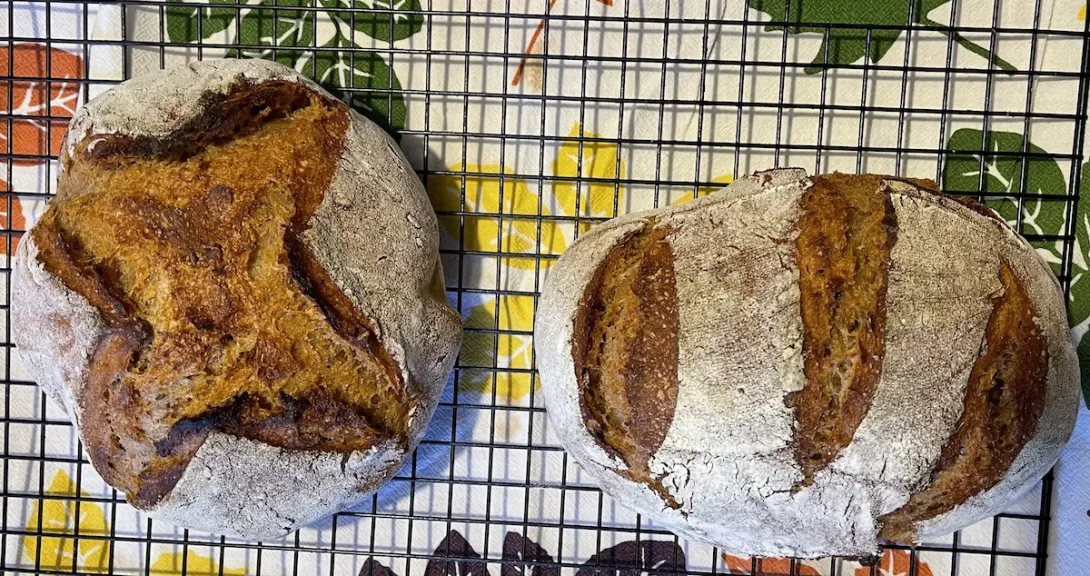
I am just beginning to suss out all the ins and outs for proofing, shaping, slashing etc., and I have a ways to go, but that said, I was not displeased with this bread. I made 2 smaller loaves (one round, one oval) from the recipe because it's just me, and I froze one. I baked the oval loaf in my ancient rompertopf and the round one in a smallish dutch oven. I really like this bread and it doesn't spike my blood sugar, which is a very grand thing!
These look amazing, well done especially as a newer baker!
Benny
Thanks! I’m reading and watching videos, trying to learn as much as I can, but I know it’s a lot of experience and trial and error. I’m enjoying the learning!
Well done! The crumb looks great and I would say your shaping and scoring are coming along just fine. Looks like your SD culture is up and running!
Thank you so much for the feedback. I made a chocolate cake with the discard. I was worried because it is rye starter, but it turned out great! I ordered some starter from Breadtopia in case this was a fail. So likes like I’ll have 2 starters soon. :)
This bread is from Jefferey Hamelman's Bread (3rd Ed.). A straight forward bake with very nice results. It has a sour rye/nutty aroma when sliced. Here are some photos and the method is detailed in my blog post.
Whatta crumb! Looks so wholesome. Gosh, so many recipes i'd love to try. Thank you so much for all your contributions to the community bake.
I know! So many breads in this thread I’d like to try. Will never get to them all.
100% rye, no measurements
I used dried out dough (2 weeks old) as a starter
So, just rye flour, water, salt, and old dough? Was it proofed seam-side down?
Paul
Yes, scraps of old dry dough, flour, water and salt, but it was a multistage process. Very hands off. First, dough was revived with lukewarm water and sugar. This woke up the wild yeast. Then, stiff starter with rye flour, to wake up the lactic cultures. Then liquid preferment and. Finally, the dough.
It's not exactly the seam, because the dough was shaped in a loaf much like a pile of playdough, no real forming here. These pretty cracks appear by themselves when the surface is dusted with flour and left to proof under thin dry cotton towel
When done as a multistage build. Using old dough and building up to the final dough in steps seems to build a lot of flavour. Very nice looking loaf.
Thanks, Abe. It's very tasty, too.
Good lord you make beautiful bread. It's exactly this kind of mottling I'm looking for in my "Stückgare mit Schluss nach unten," but cannot get it yet - canyons and chasms with good "veining" here and there. Working on it.
And you're a terrible act to try and follow, but a humble couple - one, the party crasher, just a 2-stage levain, sort of after Calvel. The other, simple schwarzbrot from Lutz Geißler's first book.
The amount of talent here is mind-blowing. I can't believe how much comes from every possible angle of and interest in baking. Thanks for the thread once again Abe, and everyone here for such a wonderful community.
5th submisson here. Bake #86.
https://www.thefreshloaf.com/node/70004/86th-bake-02162022-denisas-100-rye-take-6
I guess I kind of like this recipe. ;-)
This was with dried malt extract (DME) for sweetener.
I forgot to pre-soak the flour for the final dough.
This time the pan was greased with Crisco, and dusted with cornmeal. It was baked in a cold Lodge cast iron loaf pan, but placed on a pre-heated baking stone. There was a second baking stone two positions lower at the lowest rack position.
Nice crumb and I just love pumpkin seeds in bread. Just baked a wheat bread to test out my new pullman but now you've got me wanted rye.
Thank you so much for all your contributions to the community bake. Gotta try that recipe sometime.
I had high hopes for this recipe from theryebaker.com, but it didn't quite work for me. It is 82% rye with cornmeal; more detail is in this blog post.
Another entry for the Rye CB: (Sort of) Fleischmann’s Rye Batter Bread (60% rye). More details in my blog.
As is evident from the beautiful and diverse rye breads posted above, there are many superb rye bakers on this site (not to mention biologists), but in the spirit of collective learning, I recently came across some rye tips from bread.blog that I thought might be helpful to the rest of us to troubleshoot occasional failures. I'm interested in what factors can contribute to gummy rye bread beyond just under/over-proofing and under baking. The page also shares a few pH values for those of us inclined to use pH guided baking.
Source: https://bread.blog/enzymes-and-ph-matter-troubleshoot-my-loaf/
Delicious! I wrapped the finished 13” Pullman loaf in linen towels and left it 24 hrs. Like a tender rich cake. Very cool mouth feel and a lovely crisp deep toasted crust due to plenty of butter to prevent sticking. This dough was WET! It contained 2 YW levains one white and one Rye . It also contains my trinity of EVOO -honey - yogurt.
I saw it rising in a VERY uniform fashion as I did the bulk ferment in the pan. I counted the ridges on the pan sides to watch the progress. At one hour I saw one bubble break the surface! Triumph Paul said stop the room temp ferment immediately and I did. It continued to rise in the fridge with the cover on while it retarded till the next morning. Baked at 450 top on 20 min lowered to 400 for 20 min top on then 25 min top off. Couldn’t be happier. Such an easy rye . One bowl one pan stir proof retard bake. Can’t ask for more balanced flavor or a more beautiful crumb.
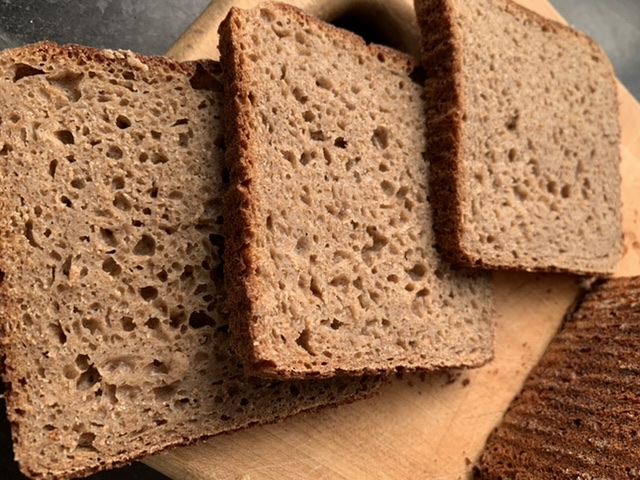
Make levains 35g white starter feed with 125g YW 125g T65 ( or other white flour)
35g rye starter feed with 125g YW 125g rye flour ( all rye was ground slightly coarse in Mock Mill)
ferment till fully developed. Overnight in the microwave with light on produced great growth.
Dough. I autolysed the the dough ingredients separately from the levain at room temp overnight due to the coarse grind.
627g coarse rye Mock Mill
557 filtered room temp H2O
90 g total Trinity - 30g each EVOO/honey/yogurt
18g salt
Mix everything together the next AM making sure it is all blended. Easy to do by hand. Butter your large Pullman and lid very very well. Place dough in and smooth top with a wet spatula. Leave in a warm place, I used the radiator in a sunny window. Mine took only one hour to see the " first fermentation bubble". Put lid on and place in fridge overnight. Bake in 450 preheated oven for 20 min covered. Lower to 400 and continue covered bake another 20 min. The slide cover off and say " whoa" as it will be so brown and full to the top and continue to bake 25 min. Remove from pan after about 10 min to let it loosen. Wrap in linen for 24 hrs. Slice and enjoy. c
Looks great Caroline! And I agree, sounds like such a simple method.
I have the Mock Mill too. When you say coarse, how do you set the mill? I usually tighten until the stones just touch. Do you do that and go backwards a certain number of clicks?
I always grind my flour including rye at the ticking sound. Since reading here on TFL recently that rye doesn’t benefit from fine grinding I decided to try a less aggressive grind. I backed up about 4 from the ticking. I did autolyse all night the flour and water with added trinity. I put the salt in in the morning when I added the levains. Our house is 70 at night so I thought it was safe to leave it. I don’t ever sift any of my grinds and don’t usually autolyse over an hour or so but in this instance I wanted to be sure the bread was digestible. I can’t eat any seeds or nuts so I figured the coarse bran might be a problem . to my grateful surprise it is very easy on my tummy! Hope you will try it and post back. c
The rest is whole wheat. Flax inside, poppy and hemp on top
Image
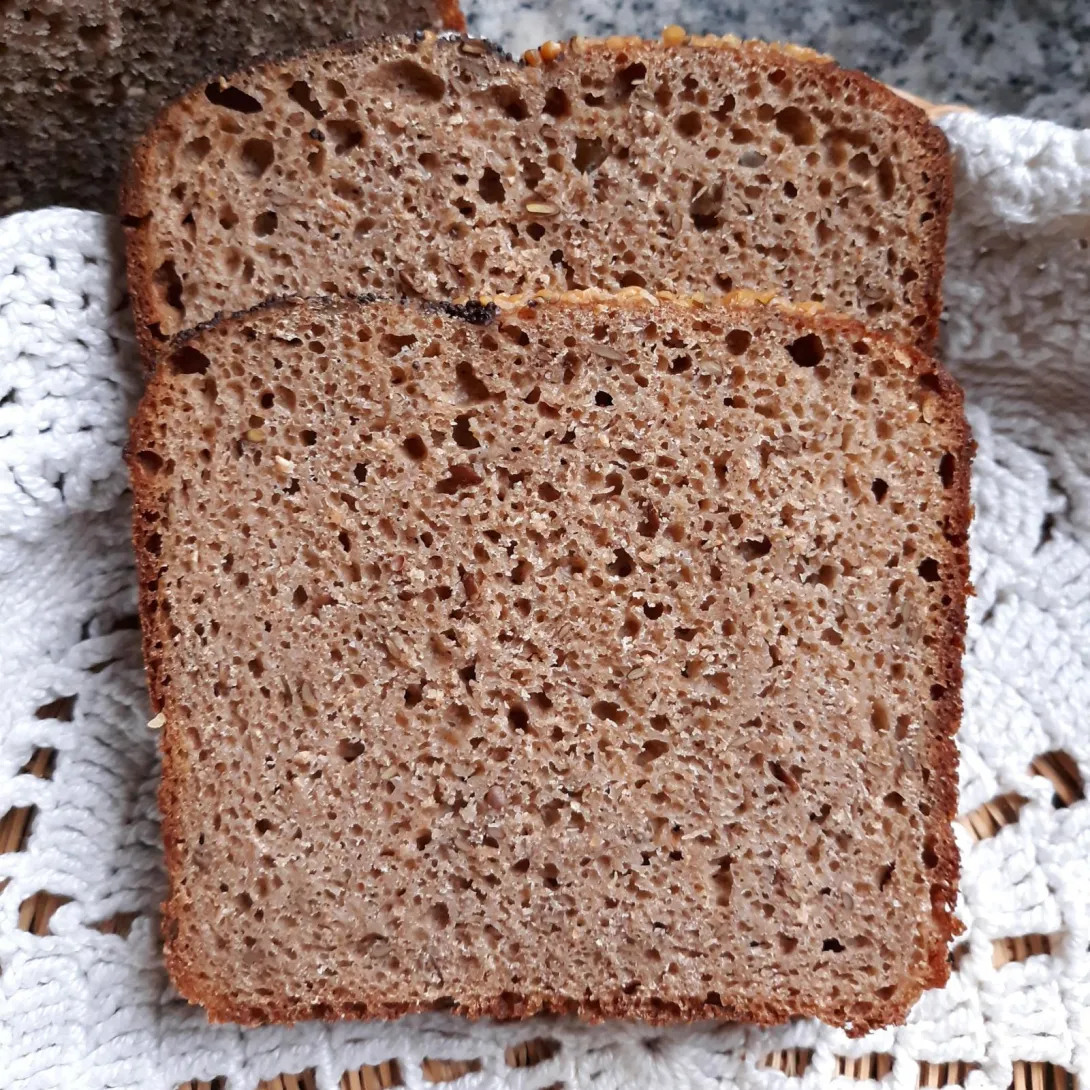
Image
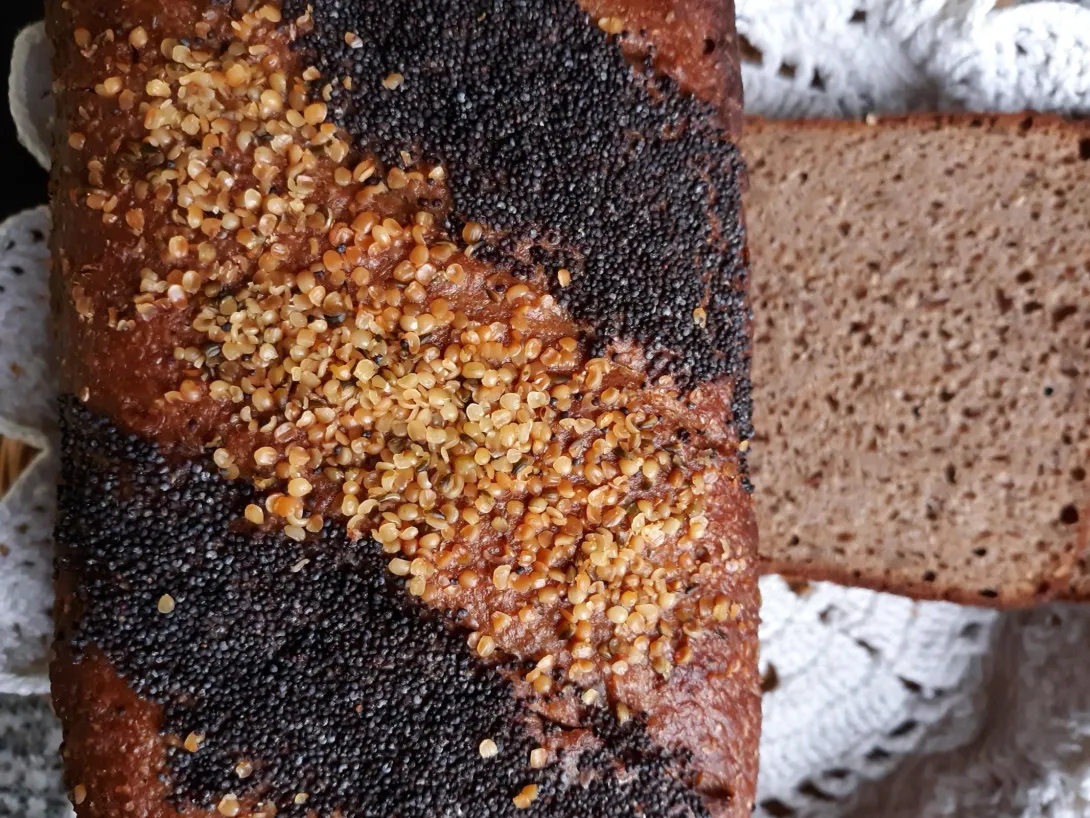
That's another beautiful looking loaf! Do you have a formula you could post? I'm partial to pan breads.
It's by volume, but always works.
Afternoon (or evening if it's warm):
2 cups whole rye flour, 1 tablespoon starter from fridge, enough lukewarm water to make pliable ball of dough; ferment in a warm spot; if your kitchen is very warm move to cooler place before bedtime
Morning:
The preferment should be expanded and filling spongy, smell pleasantly of active rye fermentation, should taste acidic
All preferment, 2 cups whole rye, 2 cups whole wheat, salt to taste, enough lukewarm water to make very soft dough, desired amount of preferred seeds (I don't soak them)
Sometimes I toss leftover oatmeal and add coffee if it's left from breakfast
Smooth the dough into a neat ball, let sit in a warm place until visibly expanded. Place in pan, proof until ready and bake
It makes tasty, somewhat acidic bread that slices nice and thin and stays fresh for a long time
This is over 50% rye, Danish style. So good and tasty. I took notes and posted them on my blog.
Image
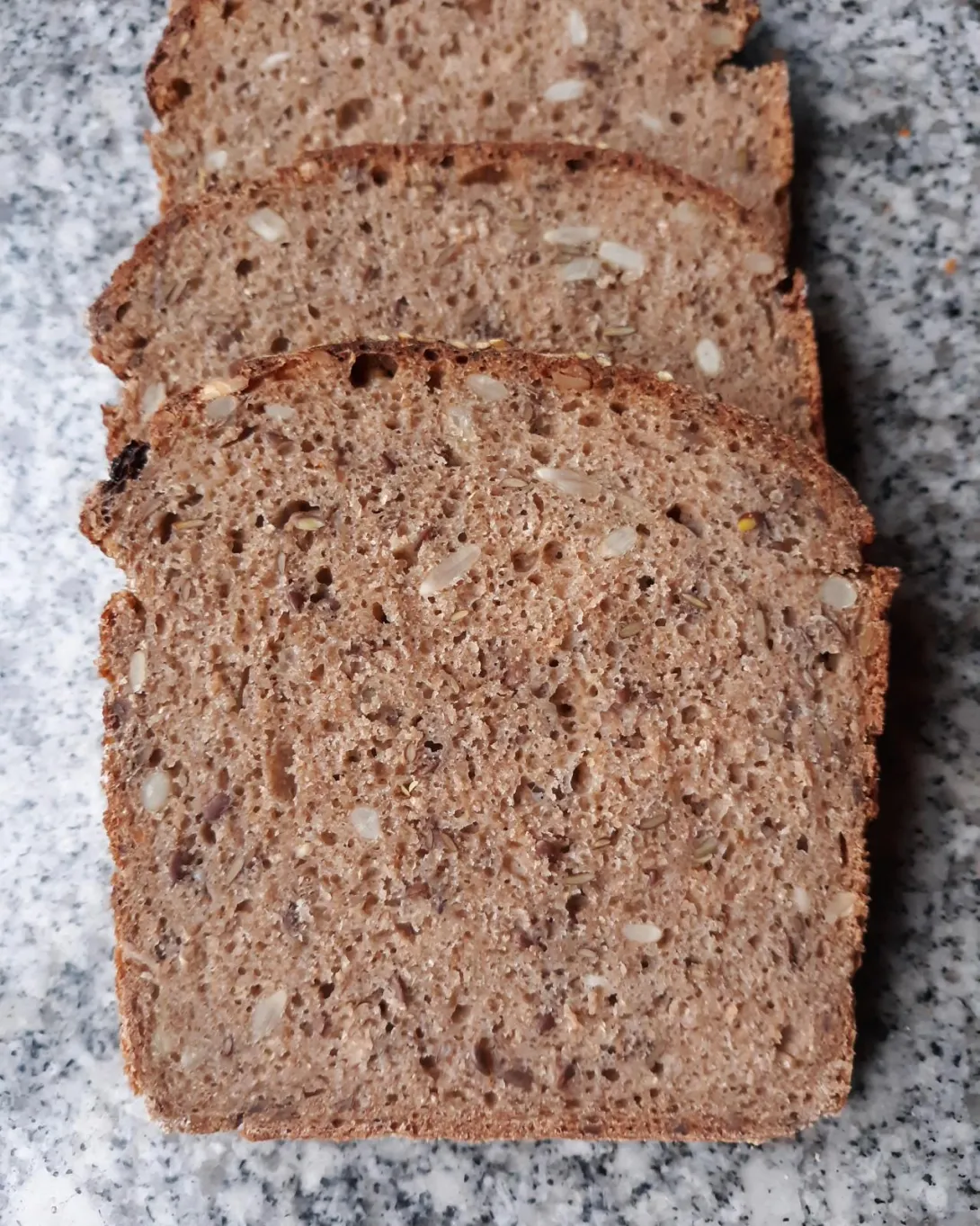
Image
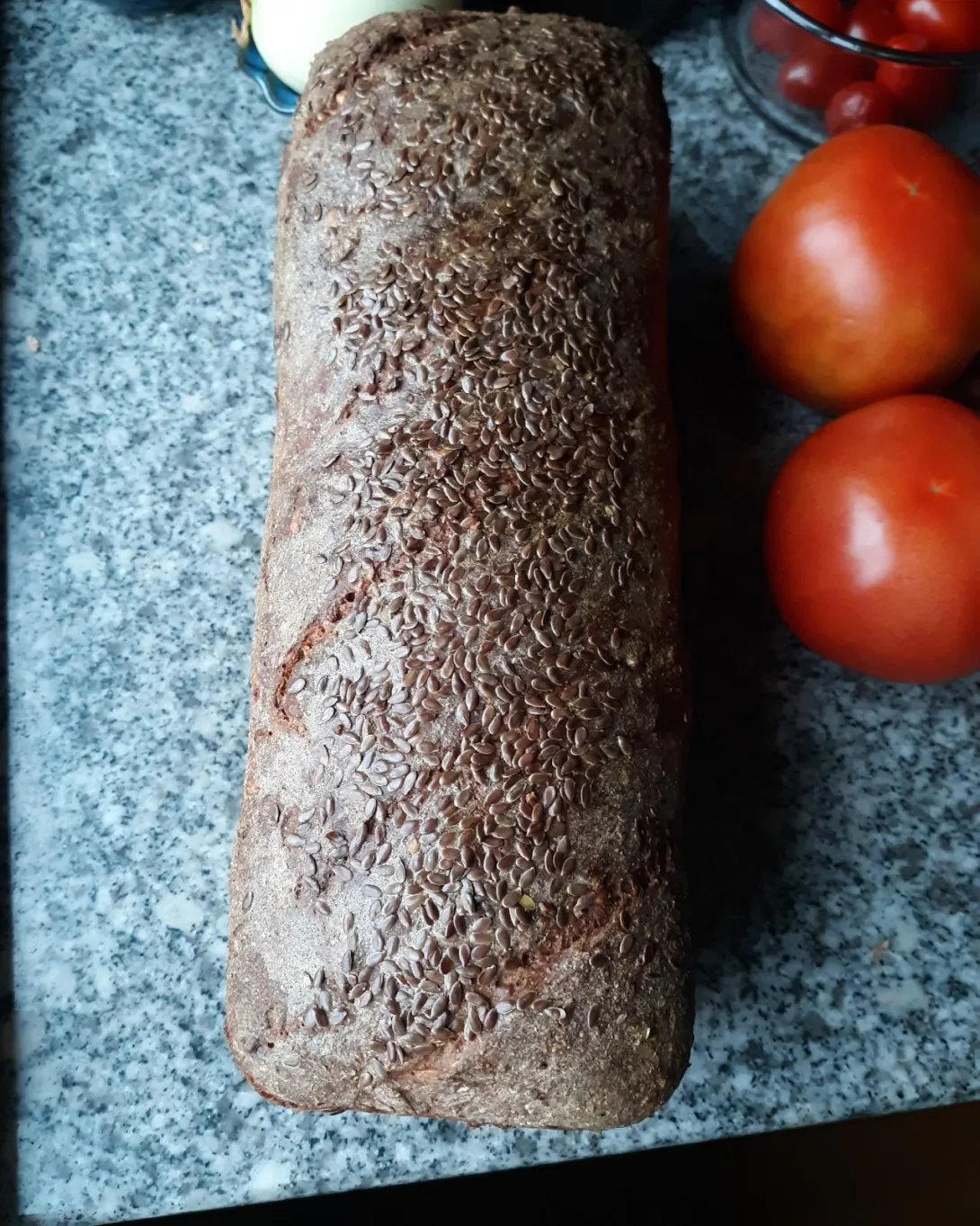
This recipe is from Der Foodcoach blog. More details on the preparation are here in my blog.
The crumb is tight and only slightly sticky. The bread has a pronounced sour, not surprising with the sour culture and buttermilk. I liked the flavor but the sourness does limit the generality of the bread. A slice at 5 days post-bake from near an end of the loaf shows some loss of structure. Is this due to poor shaping, incorrect hydration, or incorrect proofing?
I think the crack and the more open crumb in the upper middle of the loaf is a result of crumb breaking down and just starting to fall at that point inside the loaf while baking. Looking down to the bottom crumb...it looks slightly more compact in that section just above the lower crust than further up the crumb. That the sour is quite pronounced, I'd say the fermentation could have used more yeast in the dough before the matrix started to break down. The yeast in the sourdough starter is good but a boost in yeast population might be the solution. This would get the loaf earlier into the oven as well. I also think a slight increase in hydration would help the loaf expand and maybe not scoring or keeping the crust moist by a shorter stint in the linen lined basket during the final proof. Does that make sense?
Love the color crust and crumb, the free form shape with an evenly browned chestnut crust. Is the crumb dry?
Thank you for your insights, Mini. I will try these the next bake.
The slice in the photo is 5 days post-bake. The crumb initially was moist—even a little sticky—but the 5-day old slice was from the last third of the bread that had started to dry out a little. I also found a hole in my plastic bread bag that may have contributed to the drying.
79% Stone ground whole rye. 21% High extraction Bread flour.
All of the 14% protein bread flour is pre-fermented from the Lievito Madre. I am very disappointed with the lack of oven spring. More details tomorrow if the crumb is worthy.
That loaf looks really nice for 79% rye bread. I will be interested in the crumb appearance.
Did you use any steam? Many of the rye recipes I've made have a high initial temperature (>450 °F) to favor the oven spring.
This bake was the first thirty minutes with steam at 475F. I then dropped to 425 for 30 more minutes.
Many rye recipes show minimal or now oven spring, so that's quite normal! Looks nice.
Bake #1 79% stone ground whole rye naturally leavened with stiff (Lievito Madre) starter.
More information can be found at my Blog spot
Interesting recipe, with added active malt? And non-sour lievito madre... I am wondering about the crumb - the structure doesn't look perfect, clearly gets "torn" when cut. Is it a little sticky? Does it stick to the knife? How long did you leave it before cutting?
It would have benefitted with a few more hours of rest. That being said, I switched the knife just now and was more mindful with the slicing. The bread is not sticky or gummy. I am enjoying the nonsour flavor too. That being said my disappointment is with the oven spring. I was hoping for better.
Ok, then it sounds good! And these slices look better. As I said, oven spring is often nonexistent in high rye bread... Sometimes it can even shrink in the oven. So that's normal, and if you like the taste and texture, it's a success!
I have not baked a very high percentage of rye flour in quite a long time. I forgot many of the attributes to expect.
Hello, friends.
I had so much fun yesterday with the high percentage rye bake. I decided to have some more fun today!. However, before we get to that, some final words on yesterday's bread. I just had two more thin slices my wife toasted for us. I am loving the contrast of the crunchy crisp crust and the pillowy soft crumb, amazing flavor profile too.
As for today's fun, I am going to use all my willpower not to post about this again until the very end. I want to avoid the appearance of a grand performance that ends with an anticlimactic last act.
Today I will attempt to recreate the iconic Outback steakhouse pumpernickel. Copycat formulas are available all over the world wide web for this beloved butterable bread. My bake will add some twists and turns. Please comment on any other additions or omissions you have made to this bread. Also, your thoughts and general helpful tips are always welcome. Smile. My formula is below, along with photos of the sourdough family, and job #1 converting to a rye sour starter. Enjoy!
Please stop by my Blog spot for the full description of the bake and bread.
Thank you to Abe for presiding over a very informative community bake. I submit liverwurst on rye.
Hello, friends.
Can we talk about the Anourbor/Detriot Michigan rye bread baking method known as "double baking"? While winding down from my Monday, I pulled up the World wide web (Thank you Al Gore) Ha! I kill me! Sorry, I digress. I began searching for the true sour rye (N.Y. ryes) that came with our Eastern European neighbors from the old countries. The first thing I found was that these sacred formulas, which embodied the continuity of life, the very notion that what is old can be new once again, were murdered! How could this happen? What evil could have done this! Look no further than the industrial bakers. Most notably the Levy family and their slogan "You don't have to be Jewish to love our rye bread" Okay, now I am just rambling! Double baking, anyone? Photo is strictly for attention and from my archives. Tang Zhong Jewish rye.
Search for Real Rye
How to make Jewish Rye part 1
How to make Jewish Rye part-2
For my next performance... (Just kidding Cool Cat) Yes I can humbly accept constructive criticism. I promise no more about this until it is out of the oven, maybe even sliced too!
Note: With age comes wisdom. I am no longer under the misconception that everything "N.Y." is the best. That being said, don't mess with our pizza! (I don't know I think I'm funny?)
If it's good enough for Jane & Michael Stern, then that's good enough for me. 2011 article “Bread Alone: In Search of the Best Rye Bread in America,” Jane & Michael Stern sing its praises: America’s very best deli rye? No contest. We found it in Ann Arbor, Michigan, when we noticed that the bread that Zingerman’s Deli used to construct our Diana’s Different Drummer sandwich (brisket, Russian dressing, coleslaw, and horseradish) was sensational. It comes from Zingerman’s Bakehouse, which makes loaves of rugged rye that are dense and springy, laced with the taste of hearth smoke. (Saveur, March 2011)
Fascinating proces! I baked this already twice before and wanted to try again. I had to do some time squeezing and stretching so I didn't follow (timingwise) any of these recipes. But the ingredients and all the steps are here
In English: http://theryebaker.com/latgalian-rye/
In Polish: https://przepisynadomowyserichleb.blogspot.com/2017/02/chleb-zytni-penoziarnisty-atgalski-otwa.html?m=1
Nice colour on them. Thank you for all your wonderful loaves for this community bake.
This was my second time making it. I followed the Rye Baker instructions linked above. It’s a lot of fun seeing the fermentation go through the different stages. My mother-in-law was so taken with the unusual appearance that she requested a loaf next time we visit.
Image
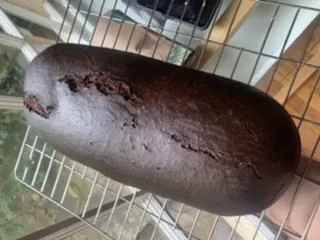
Image
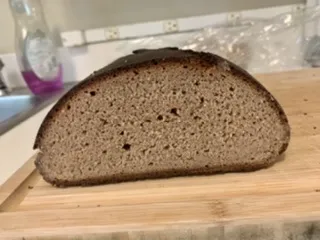
Thank you everyone for a very enjoyable community bake. Sorry I couldn't comment on each and every bake personally but that's only because of how successful it was. I'm going to ask Floyd to un-pin it from the top spot tomorrow but its always open for anyone who wishes to join in or get some ideas for a rye bake.
Thank you all!
Thanks for hosting this one Abe. There are lots of good recipes, ideas, and general information on rye baking that emerged from this chapter of the CB.
Thank you for hosting Abe! Although I didn't have time to contribute later on, there are so many other inspiring bakes. I'm sure I'll keep looking through this CB for ideas.
This was my first appearance in a CommunityBake. I learned a lot and appreciate the great wealth of knowledge presented here. c
Here's another offering for the Rye CB: traditional German Pumpernickel. The recipe is from a German bread book and conforms with the German requirements of Pumpernickel: only rye meals were used and the bake was at least 16 hours. More details can be found in my (blog).
One cautionary note: You might not want to use your favorite bread pan; my old Ecko Bakers' Secret pan corroded during the long bake!
Looks awesome! I've been going a bit crazy with German books of late - Brotdoc's Heimat book, Lutz's No. 4, Sonja Bauer's For the Love of Bread and several others (if I disappear - my wife did it), but didn't know of this book. Yippee!
Really looking forward to how it eats. It looks delicious.
Thanks! It was more sour than I expected it to be, but it mellowed over time.
The German book is a cheapie I found on Amazon. The recipes are not as complicated as the bloggers we're familiar with.
Anudder one:
https://www.thefreshloaf.com/node/70143/88thh-bake-02232022-denisas-100-rye-take-7
A little over-fermented.
Late addition, a "Münchener Hausbrot" from Brotoc's wonderful Heimat Brote: Traditionsreiche Brote aus Dem eigenen Ofen. The blog entry differs a bit from his book, but general idea.
It's a 60:40 mixed rye. Some of the rye is KA's medium and the rest of the "Type 1150" rye is my own bolted whole rye. Type 85/T 1050 wheat flour, vorteig and sauerteig.